Kelly Jensen's Blog, page 124
January 12, 2014
YA Reissue Cover Makeovers -- Updating for New Readerships
Reissues of older YA works -- those that have gone out of print, as well as those still in print but dated -- aren't a new concept. But as YA continues to grow and authors who were publishing before things heated up find themselves becoming more well-known, more older titles are seeing their covers getting facelifts. Sometimes, the reissue/redesigns come at a key anniversary for the book, as a means of introducing it to new audiences, and other times, these can come when a related book to a series appears, and the new look is meant to revive interest in it.
These reissues and redesigns typically fit newer trends in design and appeal to today's market. Unlike mid-series redesigns, where the second book in a trilogy gets a new look and that new look carries throughout the rest of the series, these books are titles that have been out already but are getting entirely new looks through and through. An example of reissue and redesigned books you might be familiar with are the reworked Ellen Hopkins books, which maintain a lot of elements of the initial book covers, but they also appear new and fresh.
I find knowing about redesigns is helpful and worthwhile because it can help me make a decision when I'm weeding and updating the YA collection at work; if I know something is being redesigned and will have a wider appeal than the books I have, I might choose to weed and replace. Likewise, it's helpful when I'm missing book two in a trilogy, as I might then choose to weed them all and replace with the updated look. It seems like 2014 is a big year for these reissue redesigns, so I thought it'd be interesting to round up a bunch of ones I've noticed recently and talk about whether they hit the mark or miss it.
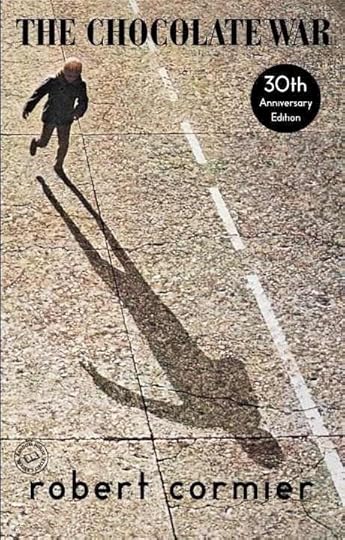

Did you know this year marks the 40th anniversary of Robert Cormier's The Chocolate War? You might remember last year's read along, and one of the things I talked about was the evolution of the book's cover. I think the reissue for the 40th anniversary on the right is excellent. It captures the mood and spirit of the book and doesn't date it in the least. I love the font treatment for the title especially. The reissued cover will be out in late spring this year.
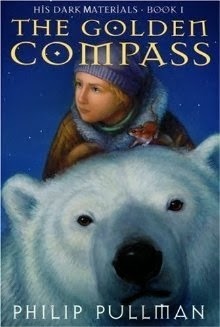

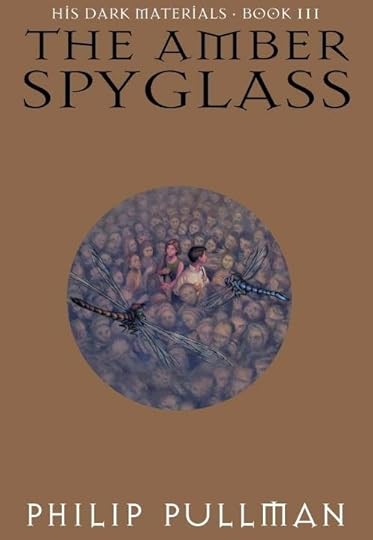
Though I think that Philip Pullman's "His Dark Materials" series might be more middle grade than YA, I wanted to include this series in my post because the redesign it's getting this spring ages it up a bit. The original covers above are illustrated and look quite juvenile. While they look appropriate for the readership, they also look dated. They look like books from the late 1990s (and early 2000s).

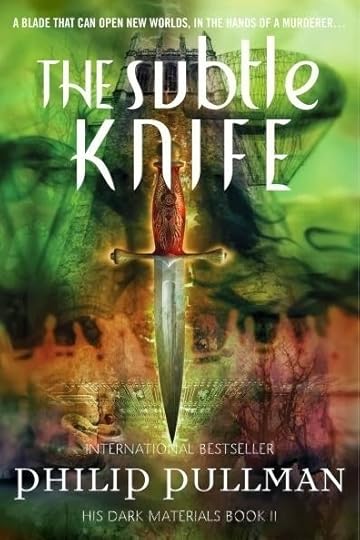
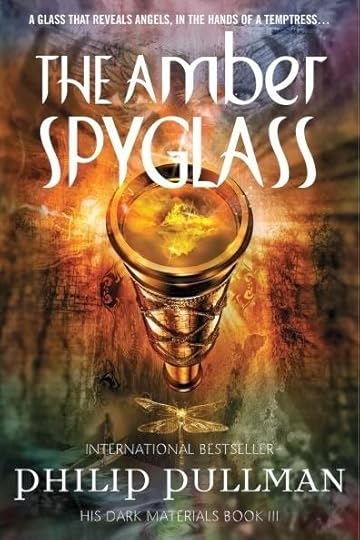
This isn't the first redesign for the series, but another one done to keep it fresh and of interest to readers. But this one certainly looks current and maybe helps age up the series too. The lack of illustrations and focus instead on an iconic image helps that. These covers will hit shelves in April.
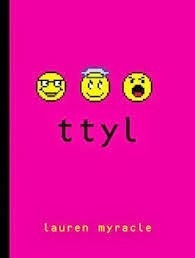
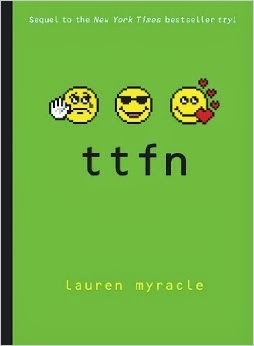
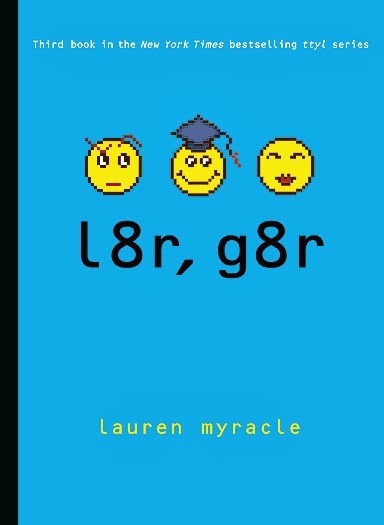
Did you know that Lauren Myracle's ttyl turns ten years old this year? It doesn't seem like they came out that long ago, but they did. The above are the original covers, and this year, in honor of the tenth anniversary, they're being reissued with new covers. And I think the new covers are excellent.
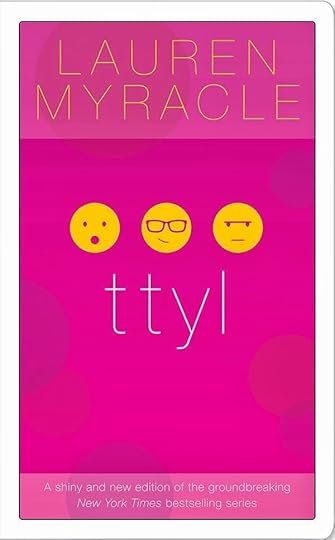
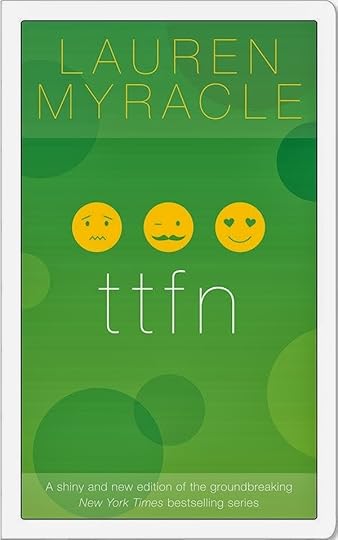
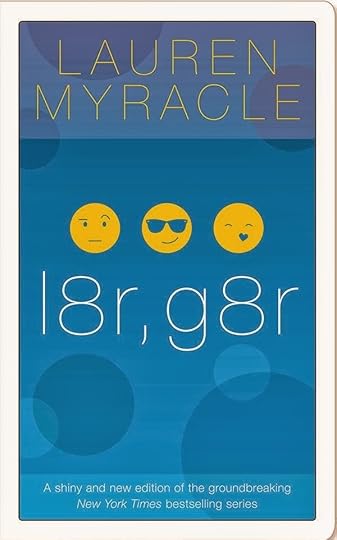
The covers are nearly identical to the originals -- right down to the color -- but they've been updated to look more clean and modern. The emoticons are in today's style, and the font used for the titles is much more in line with today's design trends. The biggest change is that Myracle's name is much larger, but it makes sense: she's really become a well-known name in YA since these books came out. Perhaps due in part to these very books.
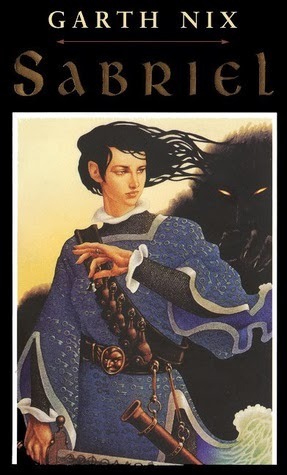
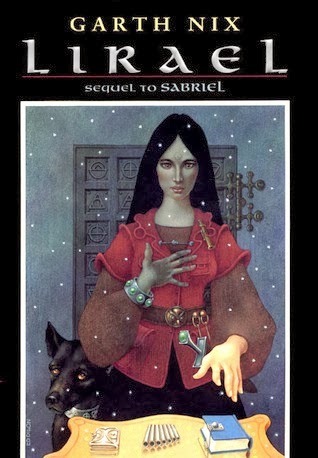
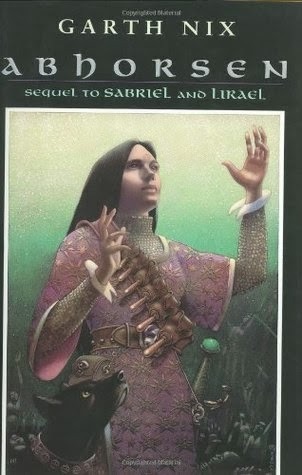
The original coves of Garth Nix's Abhorsen series are above. They've changed a little bit over the years, though these are the covers which stick out in my mind whenever I think about them -- the series came out when I was in high school.



In June, these are the covers the series will be getting. They're not bad, but they remind me a lot of the "iconic" covers of Suzanne Collins's The Hunger Games series. It's a smart move since the covers might be more timeless and they certainly fit a trend going on right now, though they might also blend in because of that. I do think it'd introduce the series to new readers since they look fresher than the originals.
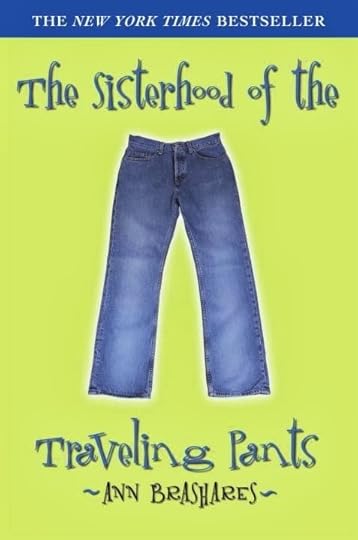

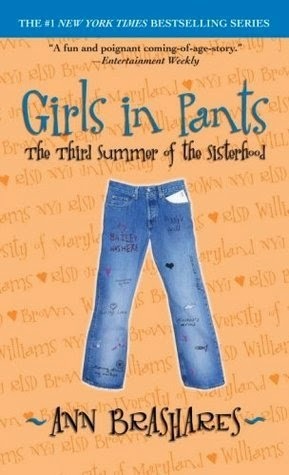
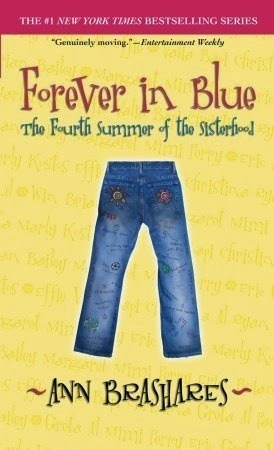
If you remember these covers for Ann Brashares's Sisterhood of the Traveling Pants series, you're probably of a certain generation. They're illustrated with nary a real girl on them.
A few years ago, they got a facelift to include actual girls with pants that look like this:
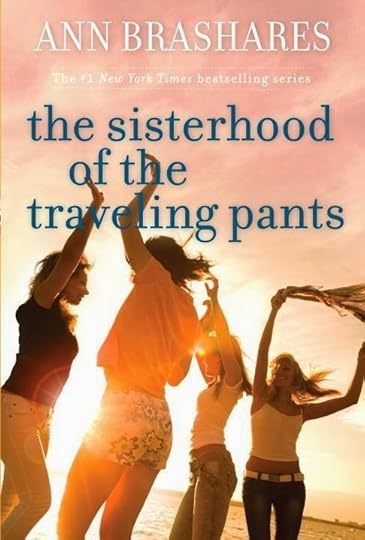
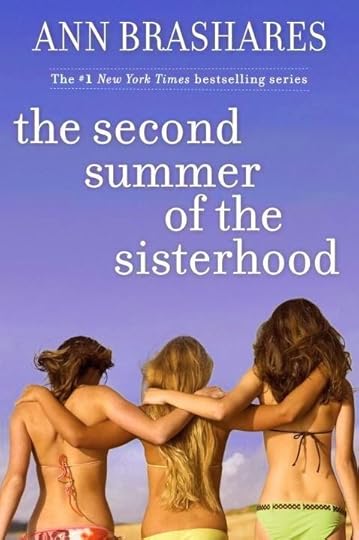
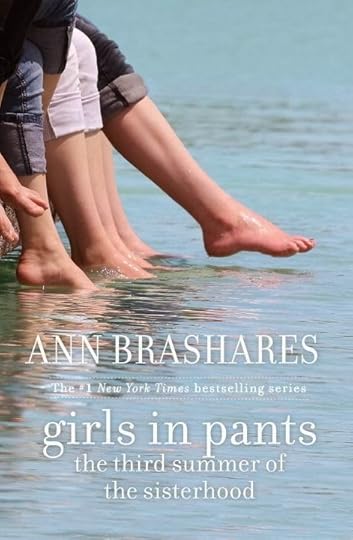
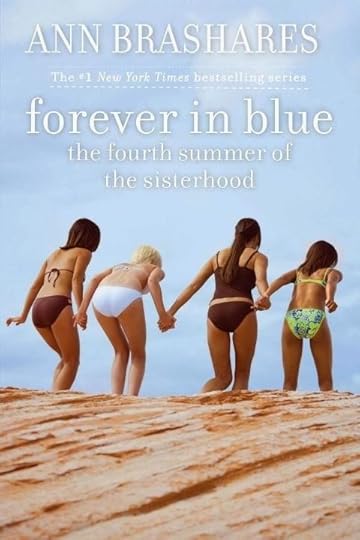
These redesigns looked like a lot of other contemporary books featuring female main characters of the time. They also looked a lot older than the original covers, which I think was -- and is -- on trend with how a lot of YA books are designed.
This series is getting another new look this April, as the paperbacks are being relaunched in anticipation of Brashares's new YA book.
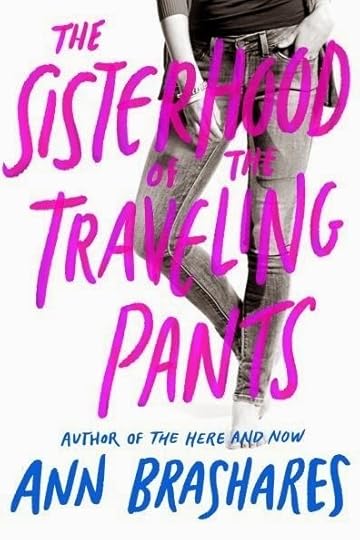
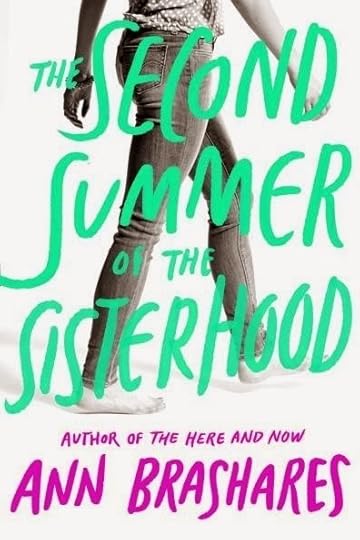

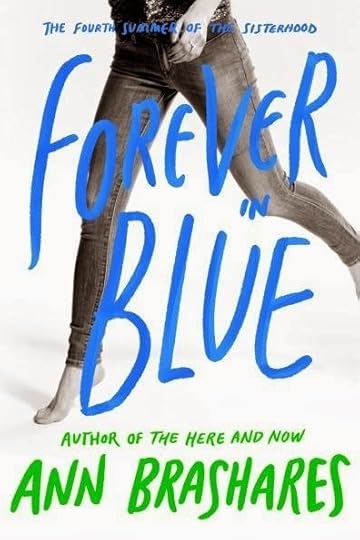
The redesigns are certainly in line with current cover trends: we have a font-driven design. Aside from the bright colored font, though, I think the new covers are really boring. They're minimalist, which I tend to like, but I think they blend too much into the landscape. There's nothing that makes them stand out (that could be said about the second set of covers I linked to, too, which I think still are appealing to teen readers). Is it me or is there some weird photoshopping going on in the third cover with the butt of that girl's jeans?
What's most interesting to me is that the author is introduced as the author of The Here and Now. She's no longer called the New York Times Bestselling author of this very series (as she was in the first set of covers).
The last series of redesigning come from Tom and Laura McNeal. Tom McNeal, as you may or may not know, wrote Far, Far Away last year, which garnered quite a bit of attention. I like the way they're going to recover and reissue his and Laura's backlists. The new looks are much fresher and appealing to today's readers -- older covers are on the left with the new covers on the right.


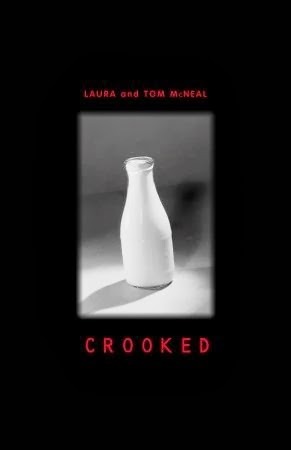
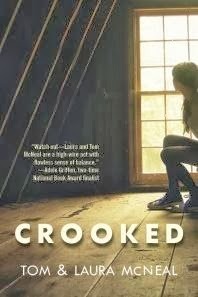
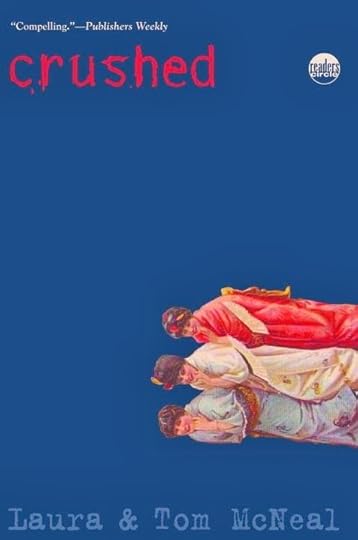
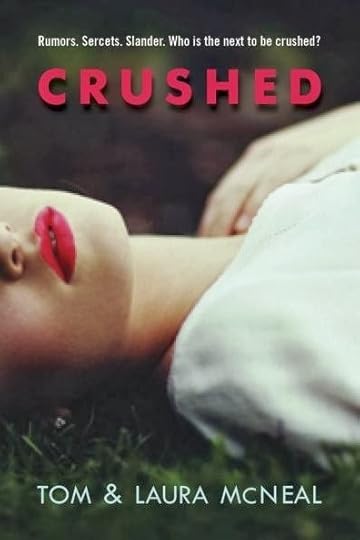


I especially like the new look to Zipped -- it has an entirely different vibe and I want to pick it up.
The reissued covers will be available June 10.
These aren't the only redesigned/reissued covers we'll be seeing in the new year. Keep an eye out for even more of Judy Blume's books to be redesigned (the first two have been revealed already over here) and Maggie Stiefvater's Shiver series is getting a bit of a facelift (it's primarily in color saturation, and you can see those redesigns here).
If you're a fan of the Anne of Green Gables series, you might already know that Sourcebooks will be reissuing those, as well. It's worth checking out the covers they're using, too, which you can see the first two covers of here.
Any of these stand out to you as winners? Any you think were better in their original looks? I'd love to know, too, if you know of other reissues coming out this year.






 Related Stories2014 YA Cover Trends: A Look at What's to Come, Part 22014 YA Cover Trends: A Look at What's to Come, Part 1Hardcover to Paperback: Six YA Book Makeovers to Consider
Related Stories2014 YA Cover Trends: A Look at What's to Come, Part 22014 YA Cover Trends: A Look at What's to Come, Part 1Hardcover to Paperback: Six YA Book Makeovers to Consider
These reissues and redesigns typically fit newer trends in design and appeal to today's market. Unlike mid-series redesigns, where the second book in a trilogy gets a new look and that new look carries throughout the rest of the series, these books are titles that have been out already but are getting entirely new looks through and through. An example of reissue and redesigned books you might be familiar with are the reworked Ellen Hopkins books, which maintain a lot of elements of the initial book covers, but they also appear new and fresh.
I find knowing about redesigns is helpful and worthwhile because it can help me make a decision when I'm weeding and updating the YA collection at work; if I know something is being redesigned and will have a wider appeal than the books I have, I might choose to weed and replace. Likewise, it's helpful when I'm missing book two in a trilogy, as I might then choose to weed them all and replace with the updated look. It seems like 2014 is a big year for these reissue redesigns, so I thought it'd be interesting to round up a bunch of ones I've noticed recently and talk about whether they hit the mark or miss it.


Did you know this year marks the 40th anniversary of Robert Cormier's The Chocolate War? You might remember last year's read along, and one of the things I talked about was the evolution of the book's cover. I think the reissue for the 40th anniversary on the right is excellent. It captures the mood and spirit of the book and doesn't date it in the least. I love the font treatment for the title especially. The reissued cover will be out in late spring this year.



Though I think that Philip Pullman's "His Dark Materials" series might be more middle grade than YA, I wanted to include this series in my post because the redesign it's getting this spring ages it up a bit. The original covers above are illustrated and look quite juvenile. While they look appropriate for the readership, they also look dated. They look like books from the late 1990s (and early 2000s).



This isn't the first redesign for the series, but another one done to keep it fresh and of interest to readers. But this one certainly looks current and maybe helps age up the series too. The lack of illustrations and focus instead on an iconic image helps that. These covers will hit shelves in April.



Did you know that Lauren Myracle's ttyl turns ten years old this year? It doesn't seem like they came out that long ago, but they did. The above are the original covers, and this year, in honor of the tenth anniversary, they're being reissued with new covers. And I think the new covers are excellent.



The covers are nearly identical to the originals -- right down to the color -- but they've been updated to look more clean and modern. The emoticons are in today's style, and the font used for the titles is much more in line with today's design trends. The biggest change is that Myracle's name is much larger, but it makes sense: she's really become a well-known name in YA since these books came out. Perhaps due in part to these very books.



The original coves of Garth Nix's Abhorsen series are above. They've changed a little bit over the years, though these are the covers which stick out in my mind whenever I think about them -- the series came out when I was in high school.



In June, these are the covers the series will be getting. They're not bad, but they remind me a lot of the "iconic" covers of Suzanne Collins's The Hunger Games series. It's a smart move since the covers might be more timeless and they certainly fit a trend going on right now, though they might also blend in because of that. I do think it'd introduce the series to new readers since they look fresher than the originals.




If you remember these covers for Ann Brashares's Sisterhood of the Traveling Pants series, you're probably of a certain generation. They're illustrated with nary a real girl on them.
A few years ago, they got a facelift to include actual girls with pants that look like this:




These redesigns looked like a lot of other contemporary books featuring female main characters of the time. They also looked a lot older than the original covers, which I think was -- and is -- on trend with how a lot of YA books are designed.
This series is getting another new look this April, as the paperbacks are being relaunched in anticipation of Brashares's new YA book.




The redesigns are certainly in line with current cover trends: we have a font-driven design. Aside from the bright colored font, though, I think the new covers are really boring. They're minimalist, which I tend to like, but I think they blend too much into the landscape. There's nothing that makes them stand out (that could be said about the second set of covers I linked to, too, which I think still are appealing to teen readers). Is it me or is there some weird photoshopping going on in the third cover with the butt of that girl's jeans?
What's most interesting to me is that the author is introduced as the author of The Here and Now. She's no longer called the New York Times Bestselling author of this very series (as she was in the first set of covers).
The last series of redesigning come from Tom and Laura McNeal. Tom McNeal, as you may or may not know, wrote Far, Far Away last year, which garnered quite a bit of attention. I like the way they're going to recover and reissue his and Laura's backlists. The new looks are much fresher and appealing to today's readers -- older covers are on the left with the new covers on the right.








I especially like the new look to Zipped -- it has an entirely different vibe and I want to pick it up.
The reissued covers will be available June 10.
These aren't the only redesigned/reissued covers we'll be seeing in the new year. Keep an eye out for even more of Judy Blume's books to be redesigned (the first two have been revealed already over here) and Maggie Stiefvater's Shiver series is getting a bit of a facelift (it's primarily in color saturation, and you can see those redesigns here).
If you're a fan of the Anne of Green Gables series, you might already know that Sourcebooks will be reissuing those, as well. It's worth checking out the covers they're using, too, which you can see the first two covers of here.
Any of these stand out to you as winners? Any you think were better in their original looks? I'd love to know, too, if you know of other reissues coming out this year.







 Related Stories2014 YA Cover Trends: A Look at What's to Come, Part 22014 YA Cover Trends: A Look at What's to Come, Part 1Hardcover to Paperback: Six YA Book Makeovers to Consider
Related Stories2014 YA Cover Trends: A Look at What's to Come, Part 22014 YA Cover Trends: A Look at What's to Come, Part 1Hardcover to Paperback: Six YA Book Makeovers to Consider
Published on January 12, 2014 22:00
January 10, 2014
Links of Note: January 11, 2014
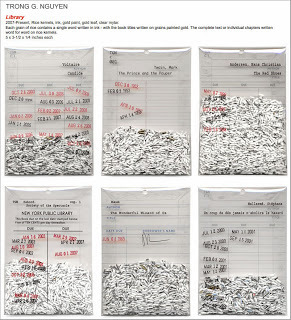 Trong G. Nguyen's library art project. Check out the rest of the library-loving artists in this roundup over at the Library as Incubator Project site.
Trong G. Nguyen's library art project. Check out the rest of the library-loving artists in this roundup over at the Library as Incubator Project site.It's been a few weeks since the last link roundup, but there's been quite a bit of good stuff to share from the book world:
Over at Cite Something, Amanda MacGregor has rounded up a number of posts that are older readers (those who aren't teens, that is) talking about favorite books they read when they were teenagers. Check out the first post, then go forward and read the ones that came up this week, too. Daniel Kraus wrote about his favorite YA and Middle Grade covers from 2013. I agree with a number of these, and I plan on talking about the paperback redesign of The Symptoms of My Insanity which I was definitely not a fan of. Also, I really want to know what the female equivalent of Winger's cover is. At School Library Journal, Shelley Diaz rounds up the 2014 kid lit being adapted into film or television. Not listed on here because technically it's not YA but a book with YA appeal is the film I'm really looking forward to: the adaptation of Jane Mendelsohn's Innocence. I loved that book as a teen, though admittedly, I'm afraid to reread it and discover I dislike it now. Flavorwire wrote about books coming to film in 2014, too, featuring both adult and teen titles. Is book banning on the rise in school and public libraries? Interesting question and thoughts about this topic at the LA Times. If you're looking to expand your reading of middle grade books, Anne Ursu wrote a great post featuring the overlooked and/or underappreciated middle grade books of 2013. The Millions posted their giant roundup of 2014 titles to get on your radar (if you're an adult book reader, and there is a lot of really great sounding stuff). This post by Peter Damien about the decline and fall of the Great Book Reviewer, a response to the New York Times OpEd about how reading is dying, is so wonderful. Go read it.
Elsewhere:
Kelly put together a quick list of ten books coming out in 2014 written by authors of color on her tumblr, and fellow tumblr users helped flesh out even more titles in the notes. If you're looking to be a better reader this year, this should help you get started. At Book Riot, 60 YA novels coming out between January and June to put on your to be read pile.







 Related StoriesLinks of Note: December 14, 2013Links of Note: Thanksgiving EditionLinks of Note: November 2, 2013
Related StoriesLinks of Note: December 14, 2013Links of Note: Thanksgiving EditionLinks of Note: November 2, 2013
Published on January 10, 2014 22:00
January 9, 2014
One Old, One New, and One Coming Soon: Three Recent Contemporary Realistic YA Reads
Since I've finished my committee reads, I've had time to finally read for me. I could write lengthy reviews on each of these, but sometimes that feels like more pressure than enjoyment. And my idea of short is longer than most people's anyway. In this set of reviews, I've got a book coming out today, a book that's been out for a few years, and a book that'll be out next month. They're very different in topic, but all are contemporary/realistic YA.
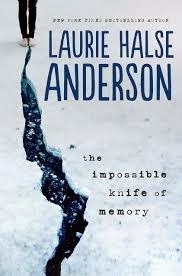 The Impossible Knife of Memory by Laurie Halse Anderson (out this week)
The Impossible Knife of Memory by Laurie Halse Anderson (out this week)
Like you'd expect of Anderson's work, this is well-written, compelling, and tackles the issue of the impact of PTSD not only on the sufferer -- who happens to be the father character -- but also on those who are related to or have a relationship to the sufferer. This is emotionally-gripping, and I thought that Anderson really knocked it out of the park with Hayley's snarky yet pained voice at the beginning of the book. That voice made the book for me, and it gave a real sense of the anguish she felt as her father's primary caregiver. But when Hayley met Finn and began a relationship with him, her edge dulled significantly. In many ways, this makes perfect sense: she finally has someone she can talk to, relate to, and having that romance is an anchor for her. I found myself less invested in Hayley and more invested in her father's well-being when it seemed like her voice shrunk.
Some of the plot points in the story were a little underexplained for me, as well. I needed to know more about the step-mother/not-a-step-mother who had been part of the reason Hayley and her father chose a life on the road in the first place. Was she an enemy? Was she to be trusted? Because by the end of the story, Hayley herself wasn't entirely sure, but she was almost too willing to trust. Given the anger which Hayley had described their relationship, it seemed too easy and convenient, and I think part of that goes back to Hayley's voice being tamped down.
The biggest let down, though, was the ending. It wrapped up far too quickly, far too easily, and the pacing in the final 15 pages of the book was way off. While the story itself spanned a few months at the beginning of the school year, once the Big Event happened at the end of the story (one that ultimately changes Hayley and her father's relationship and both of their relationships with his PTSD), nearly a year blows by in just a few pages.
The Impossible Knife of Memory has a lot of tragedy in it, and at times, it felt a little bit too much. Hayley also abandons her best friend when she's in need -- her parents are going through a big divorce -- and she does so not to help her father, but in favor of strengthening her relationship with Finn. It felt a little bit out of character for her, and given how much time speeds by in those last pages, I never got to know what happened with that plot thread nor if their relationship ever came back together. That said, it's Laurie Halse Anderson, and it's a solid contemporary YA novel. Readers who love her will pick this up and enjoy it, despite the weaknesses. Those who are new to Anderson, though, may want to start somewhere else. This is a nice addition to stories of PTSD, and interesting to me is that it publishes at the same time as Lucy Christopher's The Killing Woods, which also tackles a father's PTSD on his daughter. They're nice companions to one another.
 Making the Run by Heather Henson
Making the Run by Heather Henson
I decided to pick this one up after reading through this list of YA recs and realizing I'd never even heard of it. It's been out for a little over ten years, but topically, it's as relevant as ever.
Lu's mother died too young, and she's been grieving that loss for a long time. It's the end of her senior year and she cannot wait to leave her small town of Rainey, Kentucky, but when her older brother's best friend Jay returns to town after his own leaving-after-high-school trip, Lu begins to fall for him. Add to that a best friend whose life is changed dramatically by one bad decision and then changed even further by an accident, Lu wonders if she's destined to ever get out of Rainey or not.
Henson created a really angry girl in this story, and I thought that anger came through brilliantly. Jay says to her at one point that she either needs to use her anger or her anger will use her, and I felt that summed up the trajectory of Lu's journey. The setting was palpable, and I appreciated that Henson allowed Lu to have hopes and dreams of getting out of Rainey that weren't dependent upon her getting a scholarship and going to college. Lu's only an okay student, and she doesn't want to do that. She puts her passion into her photography, and while she doesn't know if there's a future in it, she'd rather spend time in her basement studio than hitting the books. It was refreshing to read a story where "the future" and "getting out" weren't bound up entirely in the idea of college.
I didn't feel like the rest of the characters were fleshed out quite enough, though. I never found what made Jay attractive, and while I felt bad for what happened to Lu's best friend, I found all of the ancillary characters to be merely filler. None of them felt like they had lives of their own but were instead names. In context, it made sense since that's all they were to Lu, but it made for a bit of a drag on the story.
This felt very real to me, in a way that I think a lot of current stories about middle class or lower middle class teens don't. There's not always a golden ticket out. Kids who want out have to consciously choose to do that sometimes, and I felt Lu's struggles at the end about whether she could do it or not do it were authentic. I'd pass this book off to teens who love photography, who might not be the kinds of kids who are university-bound but still have dreams and aspirations, and it's definitely the kind of story teens who live in similar towns and want nothing more than to get out will completely get. I could see readers who dig gritty stories in the vein of Gail Gailes, Heidi Ayarbe, or maybe even Ellen Hopkins. It's older, but it is definitely not dated.
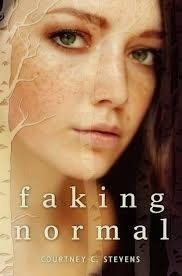
Faking Normal by Courtney Stevens (available February 25)
The reviews are likening this to Anderson's Speak or to Sarah Dessen, but I had a lot of issues with this tackling of rape What could have been a powerfully rendered story about secrets, lies, and the long-term effects of being a rape victim were instead marred by the fact this book was much more a whodunit than it was a fully-fleshed, rich, pained account of the after effects of what Alexi went through. Readers are lead astray more than once on who the criminal was here, and it was unnecessary because it removed the power and immediacy of what happened to Alexi away from her. Readers instead wonder if it was this football player, that football player, or someone else entirely. Alexi knows fully who it was, so this isn't about her figuring it out.
More than that, it became far too obsessed with Kool Aid boy and Captain Lyric (who are the same person, which is a spoiler but not a spoiler than anyone who reads a few pages wouldn't guess), and the story ends up allowing Alexi's new romantic interest to steal her story of survival. He even takes the opportunity to tell her best friend what happened, despite the fact Alexi herself hadn't felt comfortable doing so.
The story is set in the south, and it reads with that very southern feel in terms of some of what the characters say and how they act. There's nothing wrong with it, and it in fact enriches a lot of the story and characters. I forgave some of the weirdness the teens had around Kool Aid boy, who liked to dye his hair with Kool Aid, as simply something that teens where they lived did. Perhaps it was weird to them a boy would want to color his hair in weird ways (I grew up in the Chicago suburbs and teens did it every day so it was never noteworthy -- perhaps here it was).
However, there are a lot of awkward turns of phrase, and there are entire passages that needed some tighter editing. Again, I think a lot of this happened because this book didn't know what it wanted to be. Was it meant to be an exploration of the way a survivor survives? If that's the case, I never got to know what it was Alexi was really thinking or feeling. There was a lot of talking around how things were or talking through how things were, rather than talking about the things themselves. For example, Alexi took out her pain by scratching the back of her neck, but as readers, we're never privy to how that felt or the things Alexi experienced prior to doing it or in the moments while it happened. She simply told us she did it and she worried about having blood found somewhere or being discovered with her hair pulled up. There's not an immediacy to it.
What bothered me was that Alexi didn't get her own story here -- it kept being moved or displaced or handed over to someone else. And when she did get her own story, it didn't always make sense. The first football player she went on a date with also tried to assault her and she left the situation very angry about it. After accepting an apology, she then later thought that he was Captain Lyric and then changed her mind about his intentions all along. I had a hard time suspending disbelief about the relationship dynamics between Alexi's sister and fiance, especially at the end of the story. Moreover, I thought that when the reveal happened and we learn the identity of Alexi's rapist. I had an even harder time buying that the criminal had never done anything in the prior ten years that would have roused suspicions where they should have been roused. It's not that Alexi is being blamed here -- far from it. It's simply a matter of actual statistics.
I wanted more from this book and I needed less, too. Faking Normal had some charm to it, and I thought that Kool Aid boy was pretty interesting. His backstory was compelling, despite the fact I thought it was convenient how he and Alexi ended up spending so much time together. I thought Alexi herself really was pained and that what happened to her hurt her not only on a personal level but it hurt her because of the implications it would have for other people. She cared deeply about other people in a way that I think many readers will relate to -- you can't always stand up for yourself when you worry about the repercussions for other people not directly involved with something.
This is a worthwhile book because of what it tackles, but it's not the best in the field. I think the comparisons to Anderson and Dessen are a little heady, and part of me wonders if those comparisons are based because of topic more than the actual exploration of story or the writing itself.
Review copies of The Impossible Knife of Memory and Faking Normal from the publisher. I purchased my copy of Making the Run.






 Related StoriesRoomies by Tara Altebrando and Sara ZarrIndependent Study by Joelle CharbonneauGet Genrefied: Short Stories
Related StoriesRoomies by Tara Altebrando and Sara ZarrIndependent Study by Joelle CharbonneauGet Genrefied: Short Stories
 The Impossible Knife of Memory by Laurie Halse Anderson (out this week)
The Impossible Knife of Memory by Laurie Halse Anderson (out this week)Like you'd expect of Anderson's work, this is well-written, compelling, and tackles the issue of the impact of PTSD not only on the sufferer -- who happens to be the father character -- but also on those who are related to or have a relationship to the sufferer. This is emotionally-gripping, and I thought that Anderson really knocked it out of the park with Hayley's snarky yet pained voice at the beginning of the book. That voice made the book for me, and it gave a real sense of the anguish she felt as her father's primary caregiver. But when Hayley met Finn and began a relationship with him, her edge dulled significantly. In many ways, this makes perfect sense: she finally has someone she can talk to, relate to, and having that romance is an anchor for her. I found myself less invested in Hayley and more invested in her father's well-being when it seemed like her voice shrunk.
Some of the plot points in the story were a little underexplained for me, as well. I needed to know more about the step-mother/not-a-step-mother who had been part of the reason Hayley and her father chose a life on the road in the first place. Was she an enemy? Was she to be trusted? Because by the end of the story, Hayley herself wasn't entirely sure, but she was almost too willing to trust. Given the anger which Hayley had described their relationship, it seemed too easy and convenient, and I think part of that goes back to Hayley's voice being tamped down.
The biggest let down, though, was the ending. It wrapped up far too quickly, far too easily, and the pacing in the final 15 pages of the book was way off. While the story itself spanned a few months at the beginning of the school year, once the Big Event happened at the end of the story (one that ultimately changes Hayley and her father's relationship and both of their relationships with his PTSD), nearly a year blows by in just a few pages.
The Impossible Knife of Memory has a lot of tragedy in it, and at times, it felt a little bit too much. Hayley also abandons her best friend when she's in need -- her parents are going through a big divorce -- and she does so not to help her father, but in favor of strengthening her relationship with Finn. It felt a little bit out of character for her, and given how much time speeds by in those last pages, I never got to know what happened with that plot thread nor if their relationship ever came back together. That said, it's Laurie Halse Anderson, and it's a solid contemporary YA novel. Readers who love her will pick this up and enjoy it, despite the weaknesses. Those who are new to Anderson, though, may want to start somewhere else. This is a nice addition to stories of PTSD, and interesting to me is that it publishes at the same time as Lucy Christopher's The Killing Woods, which also tackles a father's PTSD on his daughter. They're nice companions to one another.
 Making the Run by Heather Henson
Making the Run by Heather HensonI decided to pick this one up after reading through this list of YA recs and realizing I'd never even heard of it. It's been out for a little over ten years, but topically, it's as relevant as ever.
Lu's mother died too young, and she's been grieving that loss for a long time. It's the end of her senior year and she cannot wait to leave her small town of Rainey, Kentucky, but when her older brother's best friend Jay returns to town after his own leaving-after-high-school trip, Lu begins to fall for him. Add to that a best friend whose life is changed dramatically by one bad decision and then changed even further by an accident, Lu wonders if she's destined to ever get out of Rainey or not.
Henson created a really angry girl in this story, and I thought that anger came through brilliantly. Jay says to her at one point that she either needs to use her anger or her anger will use her, and I felt that summed up the trajectory of Lu's journey. The setting was palpable, and I appreciated that Henson allowed Lu to have hopes and dreams of getting out of Rainey that weren't dependent upon her getting a scholarship and going to college. Lu's only an okay student, and she doesn't want to do that. She puts her passion into her photography, and while she doesn't know if there's a future in it, she'd rather spend time in her basement studio than hitting the books. It was refreshing to read a story where "the future" and "getting out" weren't bound up entirely in the idea of college.
I didn't feel like the rest of the characters were fleshed out quite enough, though. I never found what made Jay attractive, and while I felt bad for what happened to Lu's best friend, I found all of the ancillary characters to be merely filler. None of them felt like they had lives of their own but were instead names. In context, it made sense since that's all they were to Lu, but it made for a bit of a drag on the story.
This felt very real to me, in a way that I think a lot of current stories about middle class or lower middle class teens don't. There's not always a golden ticket out. Kids who want out have to consciously choose to do that sometimes, and I felt Lu's struggles at the end about whether she could do it or not do it were authentic. I'd pass this book off to teens who love photography, who might not be the kinds of kids who are university-bound but still have dreams and aspirations, and it's definitely the kind of story teens who live in similar towns and want nothing more than to get out will completely get. I could see readers who dig gritty stories in the vein of Gail Gailes, Heidi Ayarbe, or maybe even Ellen Hopkins. It's older, but it is definitely not dated.

Faking Normal by Courtney Stevens (available February 25)
The reviews are likening this to Anderson's Speak or to Sarah Dessen, but I had a lot of issues with this tackling of rape What could have been a powerfully rendered story about secrets, lies, and the long-term effects of being a rape victim were instead marred by the fact this book was much more a whodunit than it was a fully-fleshed, rich, pained account of the after effects of what Alexi went through. Readers are lead astray more than once on who the criminal was here, and it was unnecessary because it removed the power and immediacy of what happened to Alexi away from her. Readers instead wonder if it was this football player, that football player, or someone else entirely. Alexi knows fully who it was, so this isn't about her figuring it out.
More than that, it became far too obsessed with Kool Aid boy and Captain Lyric (who are the same person, which is a spoiler but not a spoiler than anyone who reads a few pages wouldn't guess), and the story ends up allowing Alexi's new romantic interest to steal her story of survival. He even takes the opportunity to tell her best friend what happened, despite the fact Alexi herself hadn't felt comfortable doing so.
The story is set in the south, and it reads with that very southern feel in terms of some of what the characters say and how they act. There's nothing wrong with it, and it in fact enriches a lot of the story and characters. I forgave some of the weirdness the teens had around Kool Aid boy, who liked to dye his hair with Kool Aid, as simply something that teens where they lived did. Perhaps it was weird to them a boy would want to color his hair in weird ways (I grew up in the Chicago suburbs and teens did it every day so it was never noteworthy -- perhaps here it was).
However, there are a lot of awkward turns of phrase, and there are entire passages that needed some tighter editing. Again, I think a lot of this happened because this book didn't know what it wanted to be. Was it meant to be an exploration of the way a survivor survives? If that's the case, I never got to know what it was Alexi was really thinking or feeling. There was a lot of talking around how things were or talking through how things were, rather than talking about the things themselves. For example, Alexi took out her pain by scratching the back of her neck, but as readers, we're never privy to how that felt or the things Alexi experienced prior to doing it or in the moments while it happened. She simply told us she did it and she worried about having blood found somewhere or being discovered with her hair pulled up. There's not an immediacy to it.
What bothered me was that Alexi didn't get her own story here -- it kept being moved or displaced or handed over to someone else. And when she did get her own story, it didn't always make sense. The first football player she went on a date with also tried to assault her and she left the situation very angry about it. After accepting an apology, she then later thought that he was Captain Lyric and then changed her mind about his intentions all along. I had a hard time suspending disbelief about the relationship dynamics between Alexi's sister and fiance, especially at the end of the story. Moreover, I thought that when the reveal happened and we learn the identity of Alexi's rapist. I had an even harder time buying that the criminal had never done anything in the prior ten years that would have roused suspicions where they should have been roused. It's not that Alexi is being blamed here -- far from it. It's simply a matter of actual statistics.
I wanted more from this book and I needed less, too. Faking Normal had some charm to it, and I thought that Kool Aid boy was pretty interesting. His backstory was compelling, despite the fact I thought it was convenient how he and Alexi ended up spending so much time together. I thought Alexi herself really was pained and that what happened to her hurt her not only on a personal level but it hurt her because of the implications it would have for other people. She cared deeply about other people in a way that I think many readers will relate to -- you can't always stand up for yourself when you worry about the repercussions for other people not directly involved with something.
This is a worthwhile book because of what it tackles, but it's not the best in the field. I think the comparisons to Anderson and Dessen are a little heady, and part of me wonders if those comparisons are based because of topic more than the actual exploration of story or the writing itself.
Review copies of The Impossible Knife of Memory and Faking Normal from the publisher. I purchased my copy of Making the Run.







 Related StoriesRoomies by Tara Altebrando and Sara ZarrIndependent Study by Joelle CharbonneauGet Genrefied: Short Stories
Related StoriesRoomies by Tara Altebrando and Sara ZarrIndependent Study by Joelle CharbonneauGet Genrefied: Short Stories
Published on January 09, 2014 22:00
January 8, 2014
Classics: Those I Love & Those I Love to Hate
We don't talk much about adult classics here at Stacked, but I'm always interested by readers' reactions to them. When I'm struggling to find common reading ground with other adults, asking them their opinion on Austen or Faulkner will often elicit some interesting discussion. As an English major in college, I read my fair share of the classics; I've only recently embraced the fact that I'm free to despise many of them (and I do).
This post is dedicated to sharing my antipathy. (I'll include a hefty dose of classics I did like for some balance.) I apologize in advance if I excoriate your favorite. Feel free to tell me how wrong I am in the comments.
Absalom, Absalom by William Faulkner
Really, I could list the entire Faulkner canon here, but let's not be greedy. I don't take exception to the content or plot. Instead, it's Faulkner's style I dislike so much. Paragraphs and punctuation are two of writing's greatest inventions. Completely eschewing them isn't an effective stylistic choice, it's a mess.
The Great Gatsby by F. Scott Fitzgerald
It's amazing how such a short book can manage to be so dull. I could never bring myself to care about Gatsby, much less be interested in any aspect of his life.
A Tale of Two Cities by Charles Dickens
This is a strange one for me to dislike, since the plot is actually pretty interesting and quite moving. Dickens' style is just not my cup of tea.
Wuthering Heights by Emily Bronte
I don't hate this one as actively as the others, but it's pretty high on the list. Peopled with an astonishing number of characters I just want to strangle, I found it neither romantic (which is fine - it's not necessary supposed to be) nor compelling. I did find it bloated and tedious, though.
And now for a change of pace, a few classics I really love:
Jane Eyre by Charlotte Bronte
Perhaps this is an obvious one, but I love this book. My love for it didn't crystallize until I re-read it in a college class and we talked at length about the "Reader, I married him" line. I love its exciting plot, how Jane grows to love such an imperfect - and arguably not very good - man, and most of all, how she comes into her own as an individual.
The Color Purple by Alice Walker
I've never before or since read a book as simultaneously horrible and hopeful as this one.
Frankenstein by Mary Shelley
Reading this one as an established SFF fan was really illuminating - I loved seeing how Shelley used the tropes I had always taken for granted. The fact that she wrote it at age 18 was inspiring, too.
Which classics do you love/hate?







This post is dedicated to sharing my antipathy. (I'll include a hefty dose of classics I did like for some balance.) I apologize in advance if I excoriate your favorite. Feel free to tell me how wrong I am in the comments.
Absalom, Absalom by William Faulkner
Really, I could list the entire Faulkner canon here, but let's not be greedy. I don't take exception to the content or plot. Instead, it's Faulkner's style I dislike so much. Paragraphs and punctuation are two of writing's greatest inventions. Completely eschewing them isn't an effective stylistic choice, it's a mess.
The Great Gatsby by F. Scott Fitzgerald
It's amazing how such a short book can manage to be so dull. I could never bring myself to care about Gatsby, much less be interested in any aspect of his life.
A Tale of Two Cities by Charles Dickens
This is a strange one for me to dislike, since the plot is actually pretty interesting and quite moving. Dickens' style is just not my cup of tea.
Wuthering Heights by Emily Bronte
I don't hate this one as actively as the others, but it's pretty high on the list. Peopled with an astonishing number of characters I just want to strangle, I found it neither romantic (which is fine - it's not necessary supposed to be) nor compelling. I did find it bloated and tedious, though.
And now for a change of pace, a few classics I really love:
Jane Eyre by Charlotte Bronte
Perhaps this is an obvious one, but I love this book. My love for it didn't crystallize until I re-read it in a college class and we talked at length about the "Reader, I married him" line. I love its exciting plot, how Jane grows to love such an imperfect - and arguably not very good - man, and most of all, how she comes into her own as an individual.
The Color Purple by Alice Walker
I've never before or since read a book as simultaneously horrible and hopeful as this one.
Frankenstein by Mary Shelley
Reading this one as an established SFF fan was really illuminating - I loved seeing how Shelley used the tropes I had always taken for granted. The fact that she wrote it at age 18 was inspiring, too.
Which classics do you love/hate?








Published on January 08, 2014 22:00
January 7, 2014
Allegiant by Veronica Roth: A Spoiler-Filled Review & Discussion
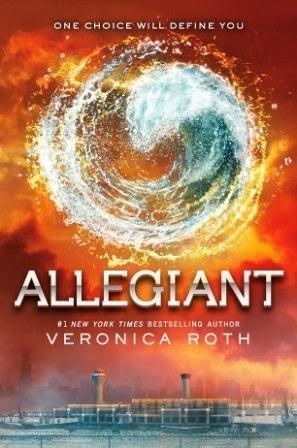 I know you've all been dying to hear my thoughts about Allegiant (approximately a month after everyone else has already moved on). I aim to please.
I know you've all been dying to hear my thoughts about Allegiant (approximately a month after everyone else has already moved on). I aim to please.I normally don't reveal anything too spoilery in my reviews, but this is the kind of book where I'd like to discuss the Big Things that happen, and spoilers are necessary. I'm also going to assume that a great many of you have read this one already.
Overall, I liked it. I didn't love it, which is in keeping with my feelings about the series as a whole. Generally, the third and concluding volume of a dystopian trilogy is the one chock full of the most secrets, usually huge ones about the very nature of the society's existence. Allegiant falls very neatly in line with this trend - the revelation about the Genetically Pure (divergent) versus Genetically Damaged (non-divergent) was the sort of thing I expected. It wasn't earth-shattering or hugely imaginative, but it made sense within the context of the story and I was satisfied by it.
That said, I was frustrated by a few plot contrivances. Partway through the story, we're told by one of the scientists helping to run the experiments that he thinks Tobias may not be truly divergent. The scientist runs genetic tests on both Tris and Tobias, and it turns out that Tobias is, indeed, "genetically damaged," and non-divergent. I would have accepted this more readily if there were an explanation given for the scientist's initial suspicion. What was it in Tobias' behavior that made the scientist believe he may not be divergent/GP? We never find out. Instead, it seems this is a shortcut to give Tobias motivation for his next set of disastrous actions and the necessary rift between him and Tris. I was disappointed by this - it seemed like forced plot manipulation, rather than something that grows organically from the story and its characters.
The introduction of Tobias' perspective has mixed results. I loved getting into his head and discovering that he is flawed, that he fears. The subplot involving his relationship with his mother has been derided by some reviewers, but I thought it was pretty great and very teen (albeit magnified). Seeing him without Tris' filter is quite illuminating and humanizes him greatly. His voice, however, is so similar to Tris' that I found myself flipping back a few pages every now and then to remind myself who was narrating.
The biggest thing, and the thing I'm most torn about, is Tris' death. Roth set up the situation perfectly so that it had to be Tris to face the death serum. She's the one with the resistance, we've known this since the first book. She's also the one who tends to sacrifice the most, even for those who have betrayed her. It had to be her to go into the room. And it would have been impossible to believe that she could have escaped alive, knowing that their plan was pretty sloppy. Of course someone was waiting for her. It seemed like Roth had made this very big decision - to kill off her protagonist - early on in the series. Because of that, it didn't feel manipulative. It's incredibly gutsy, and I love that she went there. The way it's written is heart-wrenching and highlights the importance of familial love, which always gets me.
My problem is with the existence of the serums in the first place. Yes, they're there from the beginning, so they don't quite feel like basic plot devices...but they actually kind of do. They seem so simplistic. Death serum causes you to die. Truth serum causes you to tell the truth. There doesn't seem to be much science (or even "science") behind their makeup, and the reason they exist in the first place is pretty weak. And I'm still waiting for an explanation as to why Tris was extraordinarily resistant.
My review up until this point makes it sound like I was pretty tepid toward the book, which is not the case. I liked it quite a lot. It's a hefty book, but the pages flew by for me; I was thoroughly engrossed. Yes, I've read better books, and yes, I found flaws, but this concluding volume was so readable and so well-paced and so exciting. It's certainly better than the second book. It has great ideas. It holds true to its characters. It expands the dystopian world. It introduces some hefty themes about human nature and violence. It's a solid closer and I'm a bit sad it's all over.
I'd love for others to chime in with their thoughts, particularly if you agree/disagree with any of the points I addressed here.








Published on January 07, 2014 22:00
January 6, 2014
The Reductive Approach to YA Revisited: Contemporary YA & Generosity to Readers
Over the holidays -- right before them, actually -- a review for A. S. King's Reality Boy hit the New York Times, written by John Green. The review itself wasn't necessarily noteworthy, but a line in that review struck a chord with me and it's one I've been thinking about for the past few weeks, trying to figure out exactly what was meant by it.
King’s obsession with reality makes the novel drag in places, but it’s nice to see someone subtly parody the over-the-top young adult adventure stories that dominate so-called contemporary realistic Y.A.
The review continues on, without elaborating nor explaining what's meant by this line.
I've pointed out a few times where Green's been used as a yardstick for YA fiction. Last year, a review of Andrew Smith's Winger was noted as being a part of the "Green Lit" trend. That was published in The New York Times and reduced Smith's unique story to being a part of a trend, rather than a story that stood wholly on its own. Rather than suggesting the book was a read alike to Green, the review credits Green as the standard for quality YA, especially of the realistic variety. It's the reductive approach to YA.
A review of Matt de la Pena's The Living, published in Entertainment Weekly a couple months ago, suggested that the characters in his book were "worthy of a John Green novel." I'm linking to the discussion about this as it played out on tumblr because I think it offered even more insight into the context of the review.
Article after article from publishing insiders talk about how contemporary realistic fiction is on the rise. That it's the next trend to really hit YA fiction. While I disagree that it's the next trend -- it's always been a staple of YA fiction as much as being a teenager has been a staple of being between the ages of 13 and 19 -- I think the actual trend is the rise in YA fiction that reads like or can be sold as being a John Green alike.
Here's a short list of 2014 titles being pitched as Green alikes:
Love and Other Four Letter Words by Erin McCahanSay What You Will by Cammie McGovernMaybe One Day by Melissa KantorSide Effects May Vary by Julie MurphyThe Vigilante Poets of Selwyn Academy by Kate Hattemer Starbird Murphy and The World Outside by Karen Finneyfrock (this isn't a pitch but a bookseller's quote, which reads as suggesting the book for "teen fans of John Green" -- emphasis mine)Even non-contemporary YA books are being pitched as in the vein of or for fans of John Green:
The Drowned Forest by Kristopher Reisz notes that it blends Looking for Alaska's theme of friendship with Stephen King's sense of small-town horror. Everyday Angel, a middle grade series by Victoria Schwab, is being pitched as John Green for middle grade, with a touch of magic.
I've noted before and will repeat over and over: John Green writes good books. His stories resonate with teen readers as much as they resonate with adult readers. I don't think it's necessary to talk about his contributions to the greater landscape of YA because when we talk about books and about the book world, we're talking about the words on a page. Marketing certainly plays a part in success, and there's no doubt that Green's been successful at getting his name out there. But even when all of that is stripped away, at the end of the day, he writes great books. Looking for Alaska is and will remain one of the first books that really got me into YA and it's one that I'll always hold as one of those special books to me as a reader.
The problem though is that John Green's name has become a tool of power and force in the YA world. When mainstream writers talk about YA, his name is held with affection and as an ideal to which others should aspire. Forget Stephenie Meyer and her vampires. That's laughable, and it remains a means of degrading the entire category of fiction. John Green, though -- he's helped save and revive YA fiction from being a crumbling cesspool of . . . whatever a crumbling cesspool of an entire category of fiction can be.
It's clearly not just undereducated and unfamiliar media that does this though.
I noted all of those John Green alikes above because it's clearly become a means of getting books attention. But it does precisely what I noted last year: it creates a reductive approach to YA fiction. Good books -- ones you should read -- are classified as Green alikes, regardless of whether or not they're really read alikes to his work. What does it even mean that a book is "in the tradition of The Fault In Our Stars?" Plenty of books tackled the very topics Green does in that book prior to its publication and plenty will cover them after. But I think because Green's name carries power -- and I don't need to get into the gender dynamics associated with it (I covered much of that that here and here) -- he's unfairly seen as the savior of YA, as well as the spokesperson for YA.
Fair or not, when you get the opportunity to review your fellow YA writers in the New York Times, you have a platform and a voice that makes you a spokesperson. Fair or not, when your books are seen as the standards to which others should aspire, that makes you a spokesperson.
Let me be clear in saying that I don't think Green abuses this power in the least. And I think that's not only admirable, but I think it speaks to his character and his passion for YA more broadly. That said, his defenses about his success and his popularity are hard for me to take as seriously understanding the problems people have when he is considered the voice for and savior of YA. Jennifer Lynn Barnes knocked out it of the park in this post, where she talks about the factors that have helped -- rather than hurt -- him as an author. And I think it's interesting, too, that he has denied having played a large role in the outstanding success of Rainbow Rowell's Eleanor & Park -- even the editor of the New York Times Book Review notes that his powerful, passionate, and enthusiastic review helped that book do as well as it did (and she links to one of the aforementioned articles about the trend in contemporary YA fiction).
Green was outspoken in the wake of Veronica Roth's Allegiant that readers have an obligation to be generous in their reading:
 Screen cap via dearauthor.com
Screen cap via dearauthor.com
Note that Green says that readers "are just, like, wrong about what books are/should do." So what is it that a book is or what a book should do? And more than that, why does the reader owe generosity toward a book? He doesn't offer a suggestion here, but rather a platitude that doesn't dig deeper into the implications of what being a generous reader means.
So with that all in place, let's go back to that review of Reality Boy and more specifically, that line. Let me share it again:
King’s obsession with reality makes the novel drag in places, but it’s nice to see someone subtly parody the over-the-top young adult adventure stories that dominate so-called contemporary realistic Y.A.
In this statement, Green is being a really generous reader. He notes that while King's obsession with reality makes the novel's pacing slow down, it does a great job of doing something else -- it manages to parody "over-the-top" YA adventures stories that are "dominating" contemporary realistic fiction.
But wait a minute -- what is he talking about here? What are these "over-the-top young adult adventure stories" that "dominate" the "so-called contemporary realistic Y.A." world? As the review continues, Green offers no insight into the types of books he's referring to. He's not telling us any titles nor is he telling us anything further about how King's book parodies these stories.
He sets up an argument in the same manner he does when he suggests readers need to be generous.
Perhaps it was a throwaway line, one that needed more consideration or nuanced thinking or a stronger editorial eye to challenge and expand upon it, but as someone who loves and champions for "so-called contemporary realistic Y.A." because I find the stories to be worth championing and absolutely worth getting into the hands of teenagers who are living these types of "over-the-top adventure stories" every single day, this made me scratch my head. Green's stories and Green's name itself dominate contemporary-realistic YA fiction. He's seen as the person who is bringing it back, bit by bit, and his name is being slapped onto books as fast as it can be, so those books stand a fighting chance at being seen or recognized as worth reading.
If I remember right, there's a scene or two in The Fault in Our Stars where two teenagers manage to get out of the country and go searching for a reclusive novelist. Is that not an over-the-top adventure story? Is Green critiquing his own work in light of King's parody or is he giving that critique to other books -- perhaps ones that are much more grounded in the gritty, less intelligent, less lauded work that also resonates with readers but doesn't benefit from the same sorts of privileges his own work has? Does he prefer teen characters to be of one ilk and one type? Is one type more palatable and more realistic than another? I think about this question and I consider audience specifically: is there a kind of teen or teen story in contemporary realistic that's more "real" for adult readers, as opposed to teen readers?
Without offering any insight into what books he's talking about -- and it's his right not to name names, seeing that this is a business and those people are indeed his colleagues -- he sets up an argument which can't be toppled. He suggests there is one set of books that are real realistic and there are another set of books which are over the top and "so-called" contemporary realistic YA. That there's a type of YA fiction that can parody that realistic fiction and do so subtly, in a manner that grants generosity to parts of a story which don't necessarily work. There's a yardstick for what is good and what is not, but what that yardstick is remains a mystery.
Contemporary realistic fiction is meant to be fiction based on some character's reality. Every single one of these stories is over-the-top in some capacity simply because none of these stories are non-fiction. It's fantasy. It's creative storytelling that renders characters in a world that is our world and pits them in situations that happen every single day somewhere in our world. Can it be extreme? Sure. But to deny that extreme reality doesn't happen somewhere is to deny the existence of over-the-top stuff happening to teens every single day. It's to deny that their stories are worthwhile. It suggests whatever's happening to them, whether daily or periodically or once or never (but they want to know and be informed in the event it's happening to someone they know or might know), is "over-the-top."
Isn't adolescence itself "over-the-top?"
YA's audience is all over the place, but these are stories about teenagers, and within the context of contemporary realistic fiction, the bulk of the characters in YA are themselves teenagers. Teens want to read stories about those who are like them, and this is particularly true in contemporary/realistic fiction. To suggest that what they may experience or may want to read within this subset of YA is "over the top" and can be parodied says a lot about the generosity he extends to readers, who so often are looking for an anchor or connection to these very stories.
As someone with such power in the industry, with a voice that can certainly help others gain traction and one which is so frequently cited as the golden standard within YA, this line and suggestion and the implications around it are disappointing to read.
The comment Green makes denies generosity to the reader.
What is easily dismissed as "over-the-top" to an adult reader says more about the adult reader than it does about the story, the teen in the story, or the teens who need the story.







King’s obsession with reality makes the novel drag in places, but it’s nice to see someone subtly parody the over-the-top young adult adventure stories that dominate so-called contemporary realistic Y.A.
The review continues on, without elaborating nor explaining what's meant by this line.
I've pointed out a few times where Green's been used as a yardstick for YA fiction. Last year, a review of Andrew Smith's Winger was noted as being a part of the "Green Lit" trend. That was published in The New York Times and reduced Smith's unique story to being a part of a trend, rather than a story that stood wholly on its own. Rather than suggesting the book was a read alike to Green, the review credits Green as the standard for quality YA, especially of the realistic variety. It's the reductive approach to YA.
A review of Matt de la Pena's The Living, published in Entertainment Weekly a couple months ago, suggested that the characters in his book were "worthy of a John Green novel." I'm linking to the discussion about this as it played out on tumblr because I think it offered even more insight into the context of the review.
Article after article from publishing insiders talk about how contemporary realistic fiction is on the rise. That it's the next trend to really hit YA fiction. While I disagree that it's the next trend -- it's always been a staple of YA fiction as much as being a teenager has been a staple of being between the ages of 13 and 19 -- I think the actual trend is the rise in YA fiction that reads like or can be sold as being a John Green alike.
Here's a short list of 2014 titles being pitched as Green alikes:
Love and Other Four Letter Words by Erin McCahanSay What You Will by Cammie McGovernMaybe One Day by Melissa KantorSide Effects May Vary by Julie MurphyThe Vigilante Poets of Selwyn Academy by Kate Hattemer Starbird Murphy and The World Outside by Karen Finneyfrock (this isn't a pitch but a bookseller's quote, which reads as suggesting the book for "teen fans of John Green" -- emphasis mine)Even non-contemporary YA books are being pitched as in the vein of or for fans of John Green:
The Drowned Forest by Kristopher Reisz notes that it blends Looking for Alaska's theme of friendship with Stephen King's sense of small-town horror. Everyday Angel, a middle grade series by Victoria Schwab, is being pitched as John Green for middle grade, with a touch of magic.
I've noted before and will repeat over and over: John Green writes good books. His stories resonate with teen readers as much as they resonate with adult readers. I don't think it's necessary to talk about his contributions to the greater landscape of YA because when we talk about books and about the book world, we're talking about the words on a page. Marketing certainly plays a part in success, and there's no doubt that Green's been successful at getting his name out there. But even when all of that is stripped away, at the end of the day, he writes great books. Looking for Alaska is and will remain one of the first books that really got me into YA and it's one that I'll always hold as one of those special books to me as a reader.
The problem though is that John Green's name has become a tool of power and force in the YA world. When mainstream writers talk about YA, his name is held with affection and as an ideal to which others should aspire. Forget Stephenie Meyer and her vampires. That's laughable, and it remains a means of degrading the entire category of fiction. John Green, though -- he's helped save and revive YA fiction from being a crumbling cesspool of . . . whatever a crumbling cesspool of an entire category of fiction can be.
It's clearly not just undereducated and unfamiliar media that does this though.
I noted all of those John Green alikes above because it's clearly become a means of getting books attention. But it does precisely what I noted last year: it creates a reductive approach to YA fiction. Good books -- ones you should read -- are classified as Green alikes, regardless of whether or not they're really read alikes to his work. What does it even mean that a book is "in the tradition of The Fault In Our Stars?" Plenty of books tackled the very topics Green does in that book prior to its publication and plenty will cover them after. But I think because Green's name carries power -- and I don't need to get into the gender dynamics associated with it (I covered much of that that here and here) -- he's unfairly seen as the savior of YA, as well as the spokesperson for YA.
Fair or not, when you get the opportunity to review your fellow YA writers in the New York Times, you have a platform and a voice that makes you a spokesperson. Fair or not, when your books are seen as the standards to which others should aspire, that makes you a spokesperson.
Let me be clear in saying that I don't think Green abuses this power in the least. And I think that's not only admirable, but I think it speaks to his character and his passion for YA more broadly. That said, his defenses about his success and his popularity are hard for me to take as seriously understanding the problems people have when he is considered the voice for and savior of YA. Jennifer Lynn Barnes knocked out it of the park in this post, where she talks about the factors that have helped -- rather than hurt -- him as an author. And I think it's interesting, too, that he has denied having played a large role in the outstanding success of Rainbow Rowell's Eleanor & Park -- even the editor of the New York Times Book Review notes that his powerful, passionate, and enthusiastic review helped that book do as well as it did (and she links to one of the aforementioned articles about the trend in contemporary YA fiction).
Green was outspoken in the wake of Veronica Roth's Allegiant that readers have an obligation to be generous in their reading:
 Screen cap via dearauthor.com
Screen cap via dearauthor.comNote that Green says that readers "are just, like, wrong about what books are/should do." So what is it that a book is or what a book should do? And more than that, why does the reader owe generosity toward a book? He doesn't offer a suggestion here, but rather a platitude that doesn't dig deeper into the implications of what being a generous reader means.
So with that all in place, let's go back to that review of Reality Boy and more specifically, that line. Let me share it again:
King’s obsession with reality makes the novel drag in places, but it’s nice to see someone subtly parody the over-the-top young adult adventure stories that dominate so-called contemporary realistic Y.A.
In this statement, Green is being a really generous reader. He notes that while King's obsession with reality makes the novel's pacing slow down, it does a great job of doing something else -- it manages to parody "over-the-top" YA adventures stories that are "dominating" contemporary realistic fiction.
But wait a minute -- what is he talking about here? What are these "over-the-top young adult adventure stories" that "dominate" the "so-called contemporary realistic Y.A." world? As the review continues, Green offers no insight into the types of books he's referring to. He's not telling us any titles nor is he telling us anything further about how King's book parodies these stories.
He sets up an argument in the same manner he does when he suggests readers need to be generous.
Perhaps it was a throwaway line, one that needed more consideration or nuanced thinking or a stronger editorial eye to challenge and expand upon it, but as someone who loves and champions for "so-called contemporary realistic Y.A." because I find the stories to be worth championing and absolutely worth getting into the hands of teenagers who are living these types of "over-the-top adventure stories" every single day, this made me scratch my head. Green's stories and Green's name itself dominate contemporary-realistic YA fiction. He's seen as the person who is bringing it back, bit by bit, and his name is being slapped onto books as fast as it can be, so those books stand a fighting chance at being seen or recognized as worth reading.
If I remember right, there's a scene or two in The Fault in Our Stars where two teenagers manage to get out of the country and go searching for a reclusive novelist. Is that not an over-the-top adventure story? Is Green critiquing his own work in light of King's parody or is he giving that critique to other books -- perhaps ones that are much more grounded in the gritty, less intelligent, less lauded work that also resonates with readers but doesn't benefit from the same sorts of privileges his own work has? Does he prefer teen characters to be of one ilk and one type? Is one type more palatable and more realistic than another? I think about this question and I consider audience specifically: is there a kind of teen or teen story in contemporary realistic that's more "real" for adult readers, as opposed to teen readers?
Without offering any insight into what books he's talking about -- and it's his right not to name names, seeing that this is a business and those people are indeed his colleagues -- he sets up an argument which can't be toppled. He suggests there is one set of books that are real realistic and there are another set of books which are over the top and "so-called" contemporary realistic YA. That there's a type of YA fiction that can parody that realistic fiction and do so subtly, in a manner that grants generosity to parts of a story which don't necessarily work. There's a yardstick for what is good and what is not, but what that yardstick is remains a mystery.
Contemporary realistic fiction is meant to be fiction based on some character's reality. Every single one of these stories is over-the-top in some capacity simply because none of these stories are non-fiction. It's fantasy. It's creative storytelling that renders characters in a world that is our world and pits them in situations that happen every single day somewhere in our world. Can it be extreme? Sure. But to deny that extreme reality doesn't happen somewhere is to deny the existence of over-the-top stuff happening to teens every single day. It's to deny that their stories are worthwhile. It suggests whatever's happening to them, whether daily or periodically or once or never (but they want to know and be informed in the event it's happening to someone they know or might know), is "over-the-top."
Isn't adolescence itself "over-the-top?"
YA's audience is all over the place, but these are stories about teenagers, and within the context of contemporary realistic fiction, the bulk of the characters in YA are themselves teenagers. Teens want to read stories about those who are like them, and this is particularly true in contemporary/realistic fiction. To suggest that what they may experience or may want to read within this subset of YA is "over the top" and can be parodied says a lot about the generosity he extends to readers, who so often are looking for an anchor or connection to these very stories.
As someone with such power in the industry, with a voice that can certainly help others gain traction and one which is so frequently cited as the golden standard within YA, this line and suggestion and the implications around it are disappointing to read.
The comment Green makes denies generosity to the reader.
What is easily dismissed as "over-the-top" to an adult reader says more about the adult reader than it does about the story, the teen in the story, or the teens who need the story.








Published on January 06, 2014 22:00
January 5, 2014
Get Genrefied: Short Stories
Every month last year we featured a genre or a format of YA fiction, talked about the defining characteristics, resources for learning more about them, and then a book list of current titles. If you go back and check out last month's guide on humor, you can get through to all of the guides before. Because we enjoyed writing the series, we're continuing it this year, and we have twelve new genres and/or formats to tackle. To kick it off, we're going to start with the short story.
Like graphic novels, short stories are a format, rather than a genre, since they can be written in any genre. Short stories can be fiction or non-fiction; there are short stories that are more about personal experiences (think very short memoirs) and they're non-fiction. They may also be written and illustrated in graphic format.
Short stories are shorter in length than a novel or a novella, though the word counts on what defines each of those varies. The Science Fiction Writers of America define a short story as being under 7,500 words, a novelette as a story between 7,500 and 17,500 words, a novella as a story between 17,500 and 40,000 words and a novel as something over 40,000 words in length. These aren't strict rules or laws, and there's a lot of flexibility and leeway, but they give a general idea of how short stories differ from novels.
There's not a huge market for short stories in the YA world. The bulk of YA short stories are published in anthologies, which contain stories written by more than one author and they either revolve around a theme, a mood, or a genre. There are a few notable authors who write entire books of short stories, as well -- Margo Lanagan quickly comes to mind. Over the last few years, there's been a trend toward more publishers having authors of well-known and popular series write short story companions set within the worlds of their books. The bulk of these have been produced as e-originals, releasing at various times during the first runs of the series; most of the time, they're meant to be extras and aren't essential to understanding or enjoying the series. Veronica Roth's Divergent series, for example, has a handful of short stories and all of them are e-only. Lauren Oliver's Delirium series included a handful of short stories, but rather than keep them exclusively electronic, they were bound up and republished in print form.
Sometimes short stories can be published entirely online, as a means of giving fans a bit more or as a way of getting those who haven't read the author's work to try it -- for example, there's an e-short story by Courtney Summers to her book Fall for Anything told from the perspective of the main character's best friend available on the publisher's webpage. Other times, short stories can be included as a bonus in a release of a new print edition of a book -- the paperback editions of Malinda Lo's Huntress and Marissa Meyer's Cinder, as well as the paperback of Kiersten White's Mind Games include extra material in them. The paperback of Tiffany Schmidt's Send Me A Sign will include a bonus story told from the point of view of one of the main male characters. Sara Ryan's Empress of the World included bonus short stories in comic form, as well as other extras, and those were included in the book's reissue, rather than in its initial paperback release.
The YA novella arena has been growing, thanks in part to these digital companions to popular series books. Harper Teen Impulse is an entire line of YA novellas written by well-known YA authors that are either somehow related to the author's novels, re-worked pieces from prior anthology inclusions, or are entirely brand new material. Bloomsbury published a series of e-novellas that coincided with Sarah J. Maas's Throne of Glass series. These were originally e-only, but they will be put to print later on this year. Penguin did a prequel novella to Marie Lu's Legend series, too, which is an e-only title.
YA short stories can also be found in other places, as well. One Teen Story is a journal dedicated to exactly what it says: publishing one teen short story. The journal publishes one issue -- and one story -- nine times a year. It's very much like a zine in shape, size, format, and appearance. Cicada, as well as Sucker Literary, also publish YA short stories. There are also places like the Young Adult Review Network (YARN) that publish short stories. YARN is particularly interesting because readers may be familiar with some of the names of authors who publish short stories or poetry there; many have also published novels that are familiar.
All of these sources vet their submissions and the stories go through some sort of editorial process, so not just anyone can share something they've written. I recommend spending some time reading YA Highway's post about literary journals, as they offer even more outlets for finding YA short stories.
For readers who are eager to read short stories, there are many places and outlets in which to find them. It's a format that's adaptable to print, to digital, and to books, as well as magazines and online journals, publishers websites, and more. For books which are doing exceptionally well with readers, it's more than worthwhile to develop a reading guide to places where fans can find more stories. Perhaps noting this in a circulating copy of the book would help guide readers to more work they'd enjoy. If you work in a library that circulates e-readers to teens, one way to offer those e-original short stories or novellas would be to purchase them for that device and catalog the titles as being available on the e-reader.
There aren't any specific short story writers associations, though there are awards and honors for well-done short stories offered through many outlets. Likewise, there aren't a lot of solid short story resources which include reviews or discussions of the format for YA. Bloggers who review short stories tend to review anthologies as they're published, often discussion the individual stories on their own and within the bigger context. Books of short stories tend to be reviewed in traditional sources, as well. It'll be interesting to see what happens as e-only novellas and short stories continue to emerge: it's a trend that I see value in but question audience for (teens who have the technology and teens who have access to credit cards to use aren't necessarily large nor overlapping groups).
Here's a look at a number of YA short story collections from the last few years, as well as a preview of a few to come soon. All descriptions are from WorldCat, though much of the description of the anthologies are pretty straightforward from the titles. If you know of others published in the last five or so years, feel free to add them to the comments!
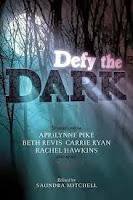
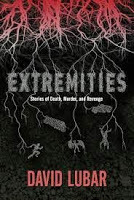
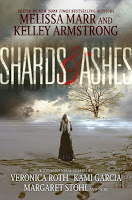
Defy the Dark edited by Saundra Mitchell: Seventeen original stories that take place in the absence of light.
Extremities by David Lubar: A group of high school girls takes revenge on their sadistic gym teacher in the most fitting way possible. Two stowaways find themselves on a ship for the dead. An ancient predator stalks the wrong victim. Here are thirteen tales of death, murder, and revenge.
Shards & Ashes edited by Melissa Marr and Kelley Armstrong: Original stories of dystopian worlds from New York Times bestselling authors.
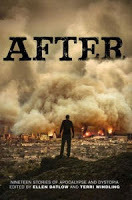
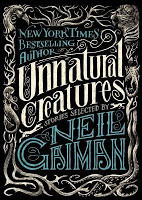
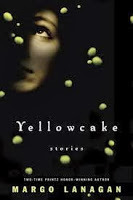
After edited by Ellen Datlow and Terri Windling: An anthology of nineteen tales by well-known authors of young adult and adult literature which explore the lives of teens raised after a catastrophe, either in the first few years after the change or in the distant future.
Unnatural Creatures edited by Neil Gaiman: A collection of sixteen stories introduces a host of strange, wondrous beings that have never existed anywhere but in the imagination, with stories from Neil Gaiman, Diana Wynne Jones, and E. Nesbit.
Yellowcake by Margo Lanagan: A collection of ten short stories of unusual people, places, and events, including reimagined classic tales and original works, most of which were previously published.
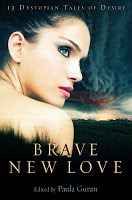
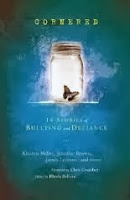
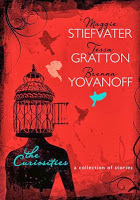
Brave New Love edited by Paula Guran: Presents a collection of fifteen stories about finding romance and danger in repressive, futuristic societies by such authors as Steve Berman, Jesse Karp, Diana Peterfreund, and Amanda Downum.
Cornered: 14 Stories of Bullying and Defiance edited by Rhoda Belleza: An anthology of fourteen stories illuminates the experiences of being bullied in today's world, in a volume that includes contributions from such established writers as Kirsten Miller, Jennifer Brown, and James Lecesne.
The Curiosities by Maggie Stiefvater, Tessa Gratton, and Brenna Yovanoff: An anthology of darkly paranormal stories, with comments by the authors on their writing process.


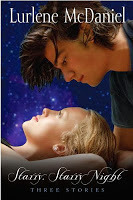
Faery Tales & Nightmares by Melissa Marr: A collection of short stories featuring tales of characters from the Wicked Lovely novels that mix with accounts of new characters.
Guys Read: Funny Business edited by Jon Scieszka: A collection of humorous stories featuring a teenaged mummy, a homicidal turkey, and the world's largest pool of chocolate milk. ("Guys Read" is an entire series of short story anthologies).
Starry, Starry Night by Lurlene McDaniel: A collection of three stories in which teenagers face life-altering situations. (This is an older anthology but it recently got a facelift).
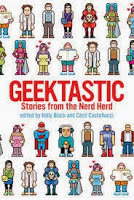
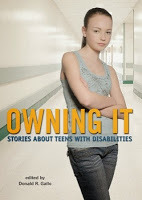
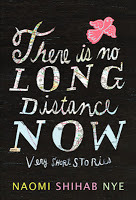
Geektastic: Stories from the Nerd Herd edited by Holly Black and Cecil Castellucci: A collection of twenty-nine short stories about geeks.
Owning It: Stories About Teens with Disabilities edited by Donald Gallo: Presents ten stories of teenagers facing all of the usual challenges of school, parents, boyfriends and girlfriends, plus the additional complications that come with having a physical or psychological disability.
There is No Long Distance Now by Naomi Shihab Nye: Forty short stories by an award-winning author and poet.
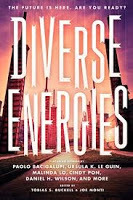
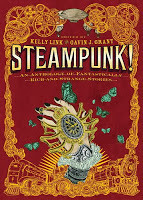
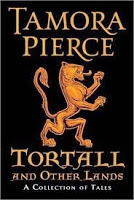
Diverse Energies edited by Tobias S. Buckell and Joe Monti: In this collection of original and rediscovered stories of tragedy and hope, the diverse stars are students, street kids, "good girls," kidnappers, and child laborers pitted against their environments, their governments, and sometimes one another as they seek answers in their dystopian worlds.
Steampunk edited by Kelley Link and Gavin J. Grant: A collection of fourteen fantasy stories by well-known authors, set in the age of steam engines and featuring automatons, clockworks, calculating machines, and other marvels that never existed.
Tortall and Other Lands by Tamora Pierce: A collection of fantasy stories by Tamora Pierce that are set in her created land of Tortall and feature a range of familiar and unknown characters.
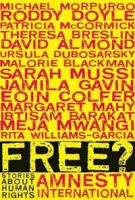
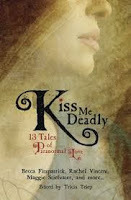
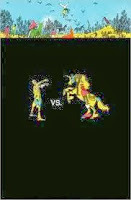
Free? Stories About Human Rights edited by Amnesty International: An anthology of fourteen stories by young adult authors from around the world, on such themes as asylum, law, education, and faith, compiled in honor of the sixtieth anniversary of the Universal Declaration of Human Rights.
Kiss Me Deadly edited by Trisha Telep and Michelle Zink: A collection of short stories combining dark seduction and modern romance presents a variety of tales featuring the romantic lives of humans and werewolves, ghosts, fallen angels, zombies, and shape-shifters.
Zombies vs. Unicorns edited by Holly Black and Justine Larbalestier: Twelve short stories by a variety of authors seek to answer the question of whether zombies are better than unicorns.
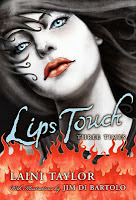
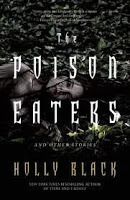
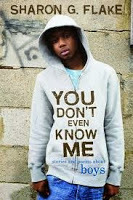
Lips Touch Three Times by Laini Taylor and illustrated by Jim di Bartolo: Three short stories about kissing, featuring elements of the supernatural.
The Poison Eaters by Holly Black: A girl wagers her soul in a sour-gummy-frog-eating contest with the devil. Love and a homemade coat rescue a boy from his fairyland jailers. A newly bitten teenage vampire uses the Internet to show the world just how uncool the "cold" life is. In this collection of stories, the supernatural intersects with everyday life in surprising and dangerous ways.
You Don't Even Know Me by Sharon G. Flake: Tow-Kaye just learned that the love of his life is pregnant--and though he knows what the right thing to do is, he's scared to death to do it. Jeffrey hates having a mom who dresses like a teenager, but when another sexy mom moves in next door--well, that's a different kind of problem. In these and twenty-two other short stories and poems, readers plumb the inner lives of African American teenage boys.

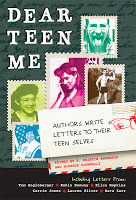
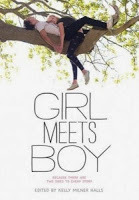
Open Mic: Riffs on Life Between Cultures edited by Mitali Perkins: Shares stories about growing up in diverse homes or communities, from an Asian youth who gains temporary popularity by making up a false background, to a biracial girl whose father clears subway seats by calmly sitting between two prejudiced women.
Dear Teen Me edited by E. Kristin Anderson and Miranda Kenneally: How many times have you looked back on your teenage years and cringed, wishing you could offer your younger self some guidance? This book of nearly 70 letters by top young adult authors -- including bestselling writers Lauren Oliver, Ellen Hopkins, and Nancy Holder -- does just that, and today's teens will benefit.
Girl Meets Boy edited by Kelly Milner Halls: Twelve authors of young adult fiction collaborate on this collection of paired stories told alternately from the point of view of the boy and the girl.
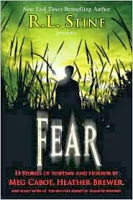
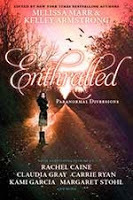
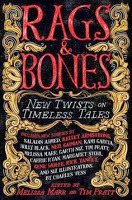
Fear: 13 Stories of Suspense and Horror edited by RL Stine: A collection of thirteen horror stories.
Enthralled edited by Melissa Marr and Kelley Armstrong: A collection of sixteen original short stories by writers of paranormal tales, featuring journeys made by teens and magical beings.
Rags & Bones: New Twists on Timeless Tales edited by Melissa Marr and Tim Pratt: In this collection, award-winning and bestselling authors reimagine their favorite classic stories, the ones that have inspired, awed, and enraged them, the ones that have become ingrained in modern culture, and the ones that have been too long overlooked.
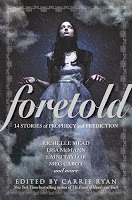
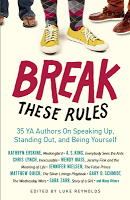
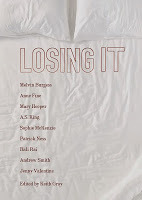
Foretold: 14 Stories of Prophecy and Prediction edited by Carrie Ryan: Collects fourteen stories that delve into the obsession with life's unknowns and the prospect of altering the future, by such authors as Meg Cabot, Diana Peterfreund, and Michael Grant.
Break These Rules: 35 YA Authors on Speaking Up, Standing Out, and Being Yourself edited by Luke Reynolds: Middle grade and young adult authors speak candidly on the unspoken "rules" of adolescence in this collection of moving, inspiring, and often funny essays. This unique volume encourages readers to break with conformity and defy age-old, and typically inaccurate, orthodoxy--including such conventions as Boys can't be gentle, kind, or caring; One must wear Abercrombie & Fitch in order to fit in; Girls should act like girls; and One must go to college after finishing high school. With contributions from acclaimed, bestselling, and award-winning young adult authors--including Gary D. Schmidt, author of The Wednesday Wars; Matthew Quick, author of The Silver Linings Playbook; Sara Zarr, author of Story of a Girl; and Wendy Mass, author of A Mango-Shaped Space--this collection encourages individuality by breaking traditionally held norms, making it an ideal resource for tweens and teens.
Losing It edited by Keith Gray: An anthology of ten stories about teens losing their virginity.
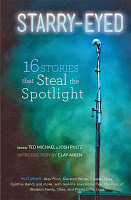
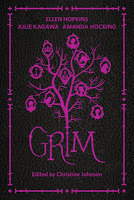
Starry-Eyed: 16 Stories that Steal the Spotlight edited by Ted Michael and Josh Pultz: Sixteen star-studded YA voices explore the glamour, struggles, and backstage chaos of the performing arts, while some of the biggest stars of stage and screen share their real-life stories of how they achieved their dreams--including American Idol finalist, Broadway star, and recording artists Clay Aiken.
Grim edited by Christine Johnson (February 2014): Inspired by classic fairy tales, but with a dark and sinister twist, Grim contains short stories from some of the best voices in young adult literature today. (Description via Goodreads).
Slasher Girls & Monster Boys edited by April Genevieve Tucholke (forthcoming 2015): Tales of gritty girls fighting back, seeking revenge, and claiming their victims. (Description via Goodreads).







 Related StoriesRoomies by Tara Altebrando and Sara ZarrLooking Ahead to Science Fiction and Fantasy in 2014: Part TwoLooking Ahead to Science Fiction and Fantasy in 2014: Part One
Related StoriesRoomies by Tara Altebrando and Sara ZarrLooking Ahead to Science Fiction and Fantasy in 2014: Part TwoLooking Ahead to Science Fiction and Fantasy in 2014: Part One
Like graphic novels, short stories are a format, rather than a genre, since they can be written in any genre. Short stories can be fiction or non-fiction; there are short stories that are more about personal experiences (think very short memoirs) and they're non-fiction. They may also be written and illustrated in graphic format.
Short stories are shorter in length than a novel or a novella, though the word counts on what defines each of those varies. The Science Fiction Writers of America define a short story as being under 7,500 words, a novelette as a story between 7,500 and 17,500 words, a novella as a story between 17,500 and 40,000 words and a novel as something over 40,000 words in length. These aren't strict rules or laws, and there's a lot of flexibility and leeway, but they give a general idea of how short stories differ from novels.
There's not a huge market for short stories in the YA world. The bulk of YA short stories are published in anthologies, which contain stories written by more than one author and they either revolve around a theme, a mood, or a genre. There are a few notable authors who write entire books of short stories, as well -- Margo Lanagan quickly comes to mind. Over the last few years, there's been a trend toward more publishers having authors of well-known and popular series write short story companions set within the worlds of their books. The bulk of these have been produced as e-originals, releasing at various times during the first runs of the series; most of the time, they're meant to be extras and aren't essential to understanding or enjoying the series. Veronica Roth's Divergent series, for example, has a handful of short stories and all of them are e-only. Lauren Oliver's Delirium series included a handful of short stories, but rather than keep them exclusively electronic, they were bound up and republished in print form.
Sometimes short stories can be published entirely online, as a means of giving fans a bit more or as a way of getting those who haven't read the author's work to try it -- for example, there's an e-short story by Courtney Summers to her book Fall for Anything told from the perspective of the main character's best friend available on the publisher's webpage. Other times, short stories can be included as a bonus in a release of a new print edition of a book -- the paperback editions of Malinda Lo's Huntress and Marissa Meyer's Cinder, as well as the paperback of Kiersten White's Mind Games include extra material in them. The paperback of Tiffany Schmidt's Send Me A Sign will include a bonus story told from the point of view of one of the main male characters. Sara Ryan's Empress of the World included bonus short stories in comic form, as well as other extras, and those were included in the book's reissue, rather than in its initial paperback release.
The YA novella arena has been growing, thanks in part to these digital companions to popular series books. Harper Teen Impulse is an entire line of YA novellas written by well-known YA authors that are either somehow related to the author's novels, re-worked pieces from prior anthology inclusions, or are entirely brand new material. Bloomsbury published a series of e-novellas that coincided with Sarah J. Maas's Throne of Glass series. These were originally e-only, but they will be put to print later on this year. Penguin did a prequel novella to Marie Lu's Legend series, too, which is an e-only title.
YA short stories can also be found in other places, as well. One Teen Story is a journal dedicated to exactly what it says: publishing one teen short story. The journal publishes one issue -- and one story -- nine times a year. It's very much like a zine in shape, size, format, and appearance. Cicada, as well as Sucker Literary, also publish YA short stories. There are also places like the Young Adult Review Network (YARN) that publish short stories. YARN is particularly interesting because readers may be familiar with some of the names of authors who publish short stories or poetry there; many have also published novels that are familiar.
All of these sources vet their submissions and the stories go through some sort of editorial process, so not just anyone can share something they've written. I recommend spending some time reading YA Highway's post about literary journals, as they offer even more outlets for finding YA short stories.
For readers who are eager to read short stories, there are many places and outlets in which to find them. It's a format that's adaptable to print, to digital, and to books, as well as magazines and online journals, publishers websites, and more. For books which are doing exceptionally well with readers, it's more than worthwhile to develop a reading guide to places where fans can find more stories. Perhaps noting this in a circulating copy of the book would help guide readers to more work they'd enjoy. If you work in a library that circulates e-readers to teens, one way to offer those e-original short stories or novellas would be to purchase them for that device and catalog the titles as being available on the e-reader.
There aren't any specific short story writers associations, though there are awards and honors for well-done short stories offered through many outlets. Likewise, there aren't a lot of solid short story resources which include reviews or discussions of the format for YA. Bloggers who review short stories tend to review anthologies as they're published, often discussion the individual stories on their own and within the bigger context. Books of short stories tend to be reviewed in traditional sources, as well. It'll be interesting to see what happens as e-only novellas and short stories continue to emerge: it's a trend that I see value in but question audience for (teens who have the technology and teens who have access to credit cards to use aren't necessarily large nor overlapping groups).
Here's a look at a number of YA short story collections from the last few years, as well as a preview of a few to come soon. All descriptions are from WorldCat, though much of the description of the anthologies are pretty straightforward from the titles. If you know of others published in the last five or so years, feel free to add them to the comments!



Defy the Dark edited by Saundra Mitchell: Seventeen original stories that take place in the absence of light.
Extremities by David Lubar: A group of high school girls takes revenge on their sadistic gym teacher in the most fitting way possible. Two stowaways find themselves on a ship for the dead. An ancient predator stalks the wrong victim. Here are thirteen tales of death, murder, and revenge.
Shards & Ashes edited by Melissa Marr and Kelley Armstrong: Original stories of dystopian worlds from New York Times bestselling authors.



After edited by Ellen Datlow and Terri Windling: An anthology of nineteen tales by well-known authors of young adult and adult literature which explore the lives of teens raised after a catastrophe, either in the first few years after the change or in the distant future.
Unnatural Creatures edited by Neil Gaiman: A collection of sixteen stories introduces a host of strange, wondrous beings that have never existed anywhere but in the imagination, with stories from Neil Gaiman, Diana Wynne Jones, and E. Nesbit.
Yellowcake by Margo Lanagan: A collection of ten short stories of unusual people, places, and events, including reimagined classic tales and original works, most of which were previously published.



Brave New Love edited by Paula Guran: Presents a collection of fifteen stories about finding romance and danger in repressive, futuristic societies by such authors as Steve Berman, Jesse Karp, Diana Peterfreund, and Amanda Downum.
Cornered: 14 Stories of Bullying and Defiance edited by Rhoda Belleza: An anthology of fourteen stories illuminates the experiences of being bullied in today's world, in a volume that includes contributions from such established writers as Kirsten Miller, Jennifer Brown, and James Lecesne.
The Curiosities by Maggie Stiefvater, Tessa Gratton, and Brenna Yovanoff: An anthology of darkly paranormal stories, with comments by the authors on their writing process.



Faery Tales & Nightmares by Melissa Marr: A collection of short stories featuring tales of characters from the Wicked Lovely novels that mix with accounts of new characters.
Guys Read: Funny Business edited by Jon Scieszka: A collection of humorous stories featuring a teenaged mummy, a homicidal turkey, and the world's largest pool of chocolate milk. ("Guys Read" is an entire series of short story anthologies).
Starry, Starry Night by Lurlene McDaniel: A collection of three stories in which teenagers face life-altering situations. (This is an older anthology but it recently got a facelift).



Geektastic: Stories from the Nerd Herd edited by Holly Black and Cecil Castellucci: A collection of twenty-nine short stories about geeks.
Owning It: Stories About Teens with Disabilities edited by Donald Gallo: Presents ten stories of teenagers facing all of the usual challenges of school, parents, boyfriends and girlfriends, plus the additional complications that come with having a physical or psychological disability.
There is No Long Distance Now by Naomi Shihab Nye: Forty short stories by an award-winning author and poet.



Diverse Energies edited by Tobias S. Buckell and Joe Monti: In this collection of original and rediscovered stories of tragedy and hope, the diverse stars are students, street kids, "good girls," kidnappers, and child laborers pitted against their environments, their governments, and sometimes one another as they seek answers in their dystopian worlds.
Steampunk edited by Kelley Link and Gavin J. Grant: A collection of fourteen fantasy stories by well-known authors, set in the age of steam engines and featuring automatons, clockworks, calculating machines, and other marvels that never existed.
Tortall and Other Lands by Tamora Pierce: A collection of fantasy stories by Tamora Pierce that are set in her created land of Tortall and feature a range of familiar and unknown characters.



Free? Stories About Human Rights edited by Amnesty International: An anthology of fourteen stories by young adult authors from around the world, on such themes as asylum, law, education, and faith, compiled in honor of the sixtieth anniversary of the Universal Declaration of Human Rights.
Kiss Me Deadly edited by Trisha Telep and Michelle Zink: A collection of short stories combining dark seduction and modern romance presents a variety of tales featuring the romantic lives of humans and werewolves, ghosts, fallen angels, zombies, and shape-shifters.
Zombies vs. Unicorns edited by Holly Black and Justine Larbalestier: Twelve short stories by a variety of authors seek to answer the question of whether zombies are better than unicorns.



Lips Touch Three Times by Laini Taylor and illustrated by Jim di Bartolo: Three short stories about kissing, featuring elements of the supernatural.
The Poison Eaters by Holly Black: A girl wagers her soul in a sour-gummy-frog-eating contest with the devil. Love and a homemade coat rescue a boy from his fairyland jailers. A newly bitten teenage vampire uses the Internet to show the world just how uncool the "cold" life is. In this collection of stories, the supernatural intersects with everyday life in surprising and dangerous ways.
You Don't Even Know Me by Sharon G. Flake: Tow-Kaye just learned that the love of his life is pregnant--and though he knows what the right thing to do is, he's scared to death to do it. Jeffrey hates having a mom who dresses like a teenager, but when another sexy mom moves in next door--well, that's a different kind of problem. In these and twenty-two other short stories and poems, readers plumb the inner lives of African American teenage boys.



Open Mic: Riffs on Life Between Cultures edited by Mitali Perkins: Shares stories about growing up in diverse homes or communities, from an Asian youth who gains temporary popularity by making up a false background, to a biracial girl whose father clears subway seats by calmly sitting between two prejudiced women.
Dear Teen Me edited by E. Kristin Anderson and Miranda Kenneally: How many times have you looked back on your teenage years and cringed, wishing you could offer your younger self some guidance? This book of nearly 70 letters by top young adult authors -- including bestselling writers Lauren Oliver, Ellen Hopkins, and Nancy Holder -- does just that, and today's teens will benefit.
Girl Meets Boy edited by Kelly Milner Halls: Twelve authors of young adult fiction collaborate on this collection of paired stories told alternately from the point of view of the boy and the girl.



Fear: 13 Stories of Suspense and Horror edited by RL Stine: A collection of thirteen horror stories.
Enthralled edited by Melissa Marr and Kelley Armstrong: A collection of sixteen original short stories by writers of paranormal tales, featuring journeys made by teens and magical beings.
Rags & Bones: New Twists on Timeless Tales edited by Melissa Marr and Tim Pratt: In this collection, award-winning and bestselling authors reimagine their favorite classic stories, the ones that have inspired, awed, and enraged them, the ones that have become ingrained in modern culture, and the ones that have been too long overlooked.



Foretold: 14 Stories of Prophecy and Prediction edited by Carrie Ryan: Collects fourteen stories that delve into the obsession with life's unknowns and the prospect of altering the future, by such authors as Meg Cabot, Diana Peterfreund, and Michael Grant.
Break These Rules: 35 YA Authors on Speaking Up, Standing Out, and Being Yourself edited by Luke Reynolds: Middle grade and young adult authors speak candidly on the unspoken "rules" of adolescence in this collection of moving, inspiring, and often funny essays. This unique volume encourages readers to break with conformity and defy age-old, and typically inaccurate, orthodoxy--including such conventions as Boys can't be gentle, kind, or caring; One must wear Abercrombie & Fitch in order to fit in; Girls should act like girls; and One must go to college after finishing high school. With contributions from acclaimed, bestselling, and award-winning young adult authors--including Gary D. Schmidt, author of The Wednesday Wars; Matthew Quick, author of The Silver Linings Playbook; Sara Zarr, author of Story of a Girl; and Wendy Mass, author of A Mango-Shaped Space--this collection encourages individuality by breaking traditionally held norms, making it an ideal resource for tweens and teens.
Losing It edited by Keith Gray: An anthology of ten stories about teens losing their virginity.


Starry-Eyed: 16 Stories that Steal the Spotlight edited by Ted Michael and Josh Pultz: Sixteen star-studded YA voices explore the glamour, struggles, and backstage chaos of the performing arts, while some of the biggest stars of stage and screen share their real-life stories of how they achieved their dreams--including American Idol finalist, Broadway star, and recording artists Clay Aiken.
Grim edited by Christine Johnson (February 2014): Inspired by classic fairy tales, but with a dark and sinister twist, Grim contains short stories from some of the best voices in young adult literature today. (Description via Goodreads).
Slasher Girls & Monster Boys edited by April Genevieve Tucholke (forthcoming 2015): Tales of gritty girls fighting back, seeking revenge, and claiming their victims. (Description via Goodreads).







 Related StoriesRoomies by Tara Altebrando and Sara ZarrLooking Ahead to Science Fiction and Fantasy in 2014: Part TwoLooking Ahead to Science Fiction and Fantasy in 2014: Part One
Related StoriesRoomies by Tara Altebrando and Sara ZarrLooking Ahead to Science Fiction and Fantasy in 2014: Part TwoLooking Ahead to Science Fiction and Fantasy in 2014: Part One
Published on January 05, 2014 22:00
January 3, 2014
A Quick Break - Cybils Finalists
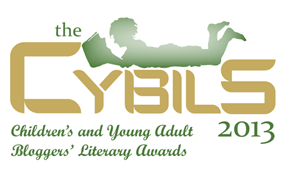
I'm a second-round judge for the YA speculative fiction Cybils awards this year. (As an aside, I love the renaming of the category this year, from fantasy and science fiction to speculative fiction. I've long felt that's a better term to describe the kind of stories that I love, and I hope this helps bring it into more popular use.)
The finalists were announced January 1, and I'm excited to dig into them. I've listed them all below, but be sure to check out the annotated list created by the Round 1 panelists at the main Cybils website.
Conjured by Sarah Beth Durst
Dark Triumph by Robin LaFevers
Pantomime by Laura Lam
Shadows by Robin McKinley
The Summer Prince by Alaya Dawn Johnson
The Waking Dark by Robin Wasserman
William Shakespeare's Star Wars by Ian Doescher








Published on January 03, 2014 13:34
December 29, 2013
We're on vacation!
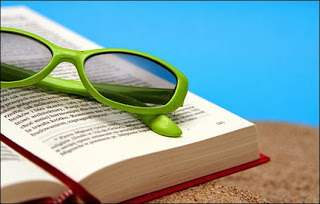
In the 4.5 years Kimberly and I have been blogging, we have never once taken a planned break. We've always had something up and ready to go.
But knowing the end of the year and start of a new one are stressful times, and they tend to be lower-readership times because of that, we decided we're taking this week to recharge, reflect, and work on some of the backend stuff here at STACKED. We're reworking some of our archives and organizational schemes here for finding content, so you might notice little things moving around, too. We're also brainstorming and putting together massive lists of things we want to write about in the coming months.
We'll be back next Monday, January 6, with programming as usual.








Published on December 29, 2013 22:00
December 26, 2013
Kelly's Top Five Posts of 2013: A Look Back
Kimberly hit on a lot of what I have to say about 2013 when it comes to blogging. We reached over a million hits, continued a couple of old series, kicked off new ones, and we passed our fourth year blogging together. In addition to all of those exciting -- and big -- milestones, 2013 was, I think, our strongest year when it came to writing and blogging more generally. I think for the first time for me, this blog felt like a real outlet and place to explore new ideas. Some of them began as small ideas and exploded into much bigger things when I wrote them out, while others I thought were bigger stayed small and confined to the blog. It was such a different year for blogging more broadly, too, which I plan on talking a bit more about next week sometime.
As Kim said, we thought it would be worthwhile to talk about some of our individual favorite posts from the past year. Here are five of my top picks, in no particular order:
Female Sexuality in YA Fiction
After writing this post back in June about female sexuality in YA, I've not stopped thinking about this topic. And I'm not just thinking about it as more books publish that tackle the subject, but I'm thinking about it in terms of backlist, too. A few people pointed me to older titles that explore female sexuality in some capacity, and I am really looking forward to reading them and thinking about how far -- or not far -- YA fiction has come in how it approaches girls and sexuality.
When We Talk About "Girl Problems"
Kind of going hand-in-hand with the sexuality post was this one about the notion of "girl problems." What does it mean to be a girl and how are the problems girls face handled in YA fiction? More than that, how are they responded to by readers? I loved talking about love triangles, as well as talking about the idea of the "every girl" that Sarah Dessen writes about (and that I think Dessen gets unfairly dinged for sometimes, too). I also think this post corresponded quite a bit with what I talked about in terms of "unlikable" female characters, too.
Getting Past the Easy Reach
When you commit something to paper (or blog, as the case may be), it's harder to ignore your own words since you have to face them if someone calls you out on them. This particular post was one that I needed to write because I needed the reminder of the value of recommending the reads that fit the reader, rather than the reads which are most obvious and easiest to grab. It was this post that really inspired me to want to write the "Beyond the Bestsellers" series at Book Riot, and it's the post I think those who do reader's advisory should think about -- I'd love to see more people talk about how to move beyond the easy reach.
Fat Isn't A Disability, But It Is A Book Deal Breaker
The more I think about my favorite posts this year, the more interrelated I see that they are. The long and short of it seems to be that it's hard to be a girl.
On Book Packagers and Literary Development Companies
This was just a straight-up fun post to write. There are posts you write that you know took you a long time to write because they required a lot of work -- I'm looking at the New York Times Bestsellers Posts -- and then there are posts you write that you know took a long time because you kept letting yourself fall down new rabbit holes. This was the rabbit hole post.
It was a real blast this year to return to the So You Want to Read YA series, as well as the Contemporary YA Week series. It was equally fun to try out a group read along for Robert Cormier's The Chocolate War, as well as giving a series about reader's advisory a shot, too. Kimberly and I both loved putting together the monthly genre guides, as well as interviewing authors we respect for our monthly Twitterview series. Of course, writing reviews for books that really worked -- as well as dissecting what didn't work within a book that wasn't a knock out for me -- is always enjoyable, too.
One thing I discovered this year and that I'll talk a bit more about in a future post is how much readership and audience has changed over the last year. When we once knew our readership pretty well, now we're less aware (and maybe less concerned, too). It's neat to see where and how people are finding us, and it's been so great to see not just our content be shared, but it's enjoyable to reader other people's responses to our posts via their own blogs, tumblr, Twitter, and other outlets. There's never a time when I don't have at least a page worth of post ideas, thanks in big part to those of you who read and think about what it is we have to say.
I'm not a resolutions person, though I do like to set goals (resolutions to me sound too absolute and focus too much on an end result, whereas goals allow for celebrating and feeling accomplishment in the interim steps along the path). In the coming year, it's my goal to keep writing what I feel like writing and to cover some of the things people have suggested I look at but I thought maybe I didn't have the time or energy to do. The truth is, that time is there. It's just a matter of sitting down and putting the effort in to do it -- and that's one of those interim steps along the way I love and look forward to but forget about until I get the chance to reflect upon the value it brings to me.
As always, a huge thank you to our readers, to those who comment or share or encourage us along the way. We'd probably still blog without it, but it'd be a much less enjoyable or inspiring experience.






 Related StoriesOur favorite books of 2013 & What we're looking forward to in 20142012 in Review
Related StoriesOur favorite books of 2013 & What we're looking forward to in 20142012 in Review
As Kim said, we thought it would be worthwhile to talk about some of our individual favorite posts from the past year. Here are five of my top picks, in no particular order:
Female Sexuality in YA Fiction
After writing this post back in June about female sexuality in YA, I've not stopped thinking about this topic. And I'm not just thinking about it as more books publish that tackle the subject, but I'm thinking about it in terms of backlist, too. A few people pointed me to older titles that explore female sexuality in some capacity, and I am really looking forward to reading them and thinking about how far -- or not far -- YA fiction has come in how it approaches girls and sexuality.
When We Talk About "Girl Problems"
Kind of going hand-in-hand with the sexuality post was this one about the notion of "girl problems." What does it mean to be a girl and how are the problems girls face handled in YA fiction? More than that, how are they responded to by readers? I loved talking about love triangles, as well as talking about the idea of the "every girl" that Sarah Dessen writes about (and that I think Dessen gets unfairly dinged for sometimes, too). I also think this post corresponded quite a bit with what I talked about in terms of "unlikable" female characters, too.
Getting Past the Easy Reach
When you commit something to paper (or blog, as the case may be), it's harder to ignore your own words since you have to face them if someone calls you out on them. This particular post was one that I needed to write because I needed the reminder of the value of recommending the reads that fit the reader, rather than the reads which are most obvious and easiest to grab. It was this post that really inspired me to want to write the "Beyond the Bestsellers" series at Book Riot, and it's the post I think those who do reader's advisory should think about -- I'd love to see more people talk about how to move beyond the easy reach.
Fat Isn't A Disability, But It Is A Book Deal Breaker
The more I think about my favorite posts this year, the more interrelated I see that they are. The long and short of it seems to be that it's hard to be a girl.
On Book Packagers and Literary Development Companies
This was just a straight-up fun post to write. There are posts you write that you know took you a long time to write because they required a lot of work -- I'm looking at the New York Times Bestsellers Posts -- and then there are posts you write that you know took a long time because you kept letting yourself fall down new rabbit holes. This was the rabbit hole post.
It was a real blast this year to return to the So You Want to Read YA series, as well as the Contemporary YA Week series. It was equally fun to try out a group read along for Robert Cormier's The Chocolate War, as well as giving a series about reader's advisory a shot, too. Kimberly and I both loved putting together the monthly genre guides, as well as interviewing authors we respect for our monthly Twitterview series. Of course, writing reviews for books that really worked -- as well as dissecting what didn't work within a book that wasn't a knock out for me -- is always enjoyable, too.
One thing I discovered this year and that I'll talk a bit more about in a future post is how much readership and audience has changed over the last year. When we once knew our readership pretty well, now we're less aware (and maybe less concerned, too). It's neat to see where and how people are finding us, and it's been so great to see not just our content be shared, but it's enjoyable to reader other people's responses to our posts via their own blogs, tumblr, Twitter, and other outlets. There's never a time when I don't have at least a page worth of post ideas, thanks in big part to those of you who read and think about what it is we have to say.
I'm not a resolutions person, though I do like to set goals (resolutions to me sound too absolute and focus too much on an end result, whereas goals allow for celebrating and feeling accomplishment in the interim steps along the path). In the coming year, it's my goal to keep writing what I feel like writing and to cover some of the things people have suggested I look at but I thought maybe I didn't have the time or energy to do. The truth is, that time is there. It's just a matter of sitting down and putting the effort in to do it -- and that's one of those interim steps along the way I love and look forward to but forget about until I get the chance to reflect upon the value it brings to me.
As always, a huge thank you to our readers, to those who comment or share or encourage us along the way. We'd probably still blog without it, but it'd be a much less enjoyable or inspiring experience.







 Related StoriesOur favorite books of 2013 & What we're looking forward to in 20142012 in Review
Related StoriesOur favorite books of 2013 & What we're looking forward to in 20142012 in Review
Published on December 26, 2013 22:00



